Flir BelgiumBA RAY101 Handheld Marine Transceiver User Manual users manual
Raymarine UK Ltd. Handheld Marine Transceiver users manual
users manual
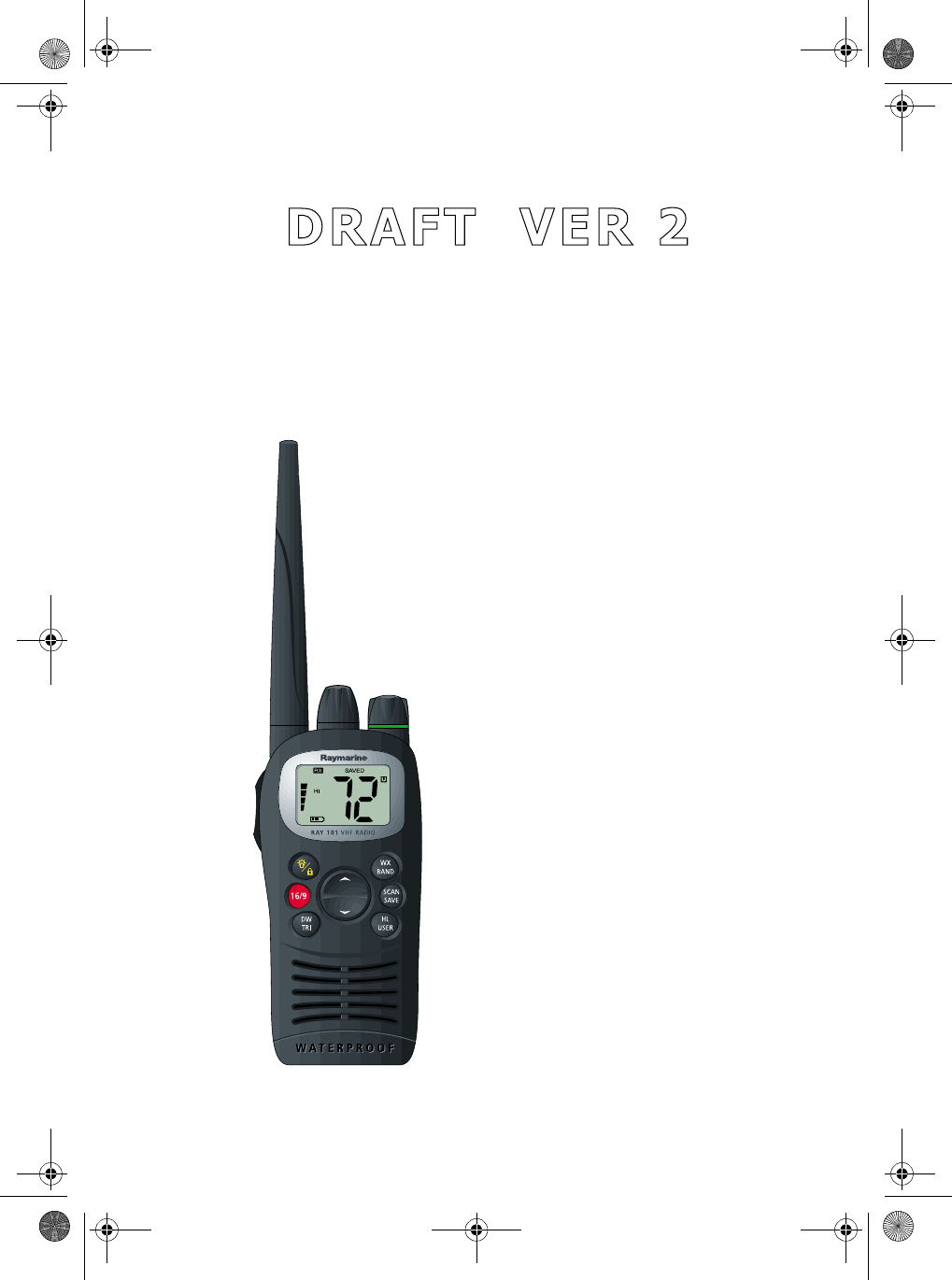
Ray101
Handheld
VHF Radio
Owner’s
Handbook
Document number: 81229_1
Date: November 2003
81229_1.book Page i Wednesday, November 12, 2003 2:39 PM

81229_1.book Page ii Wednesday, November 12, 2003 2:39 PM

iii
About this Handbook
Introduction
This handbook describes the Ray101 portable VHF marine radio. The
Ray101 provides two-way communications on all US, Canadian and
International marine channels and ten weather channels.
Conventions Used
Throughout this handbook, the dedicated (labelled) keys are shown in bold
capitals (for example: SCAN/SAVE). The LCD indicators and functions are
shown in normal capitals (for example: TX).
➤Operating procedures, which may consist of a single key-press or a
sequence of numbered steps, are indicated by an arrow icon shown in
the margin.
Technical Accuracy
To the best of our knowledge, the information in this handbook was correct
as it went to press. However, our policy of continuous product improvement
and updating may change specifications without prior notice. As a result,
unavoidable differences between the product and handbook may occur
from time to time. Raymarine cannot accept liability for any inaccuracies or
omissions it may contain.
For the latest product information visit our website:
www.raymarine.com
Warranty
To register your new Raymarine product, please take a few minutes to fill out
the warranty registration card found at the end of this handbook. It is very
important that you complete the owner information and return the card to the
factory in order to receive full warranty benefits.
81229_1.book Page iii Wednesday, November 12, 2003 2:39 PM
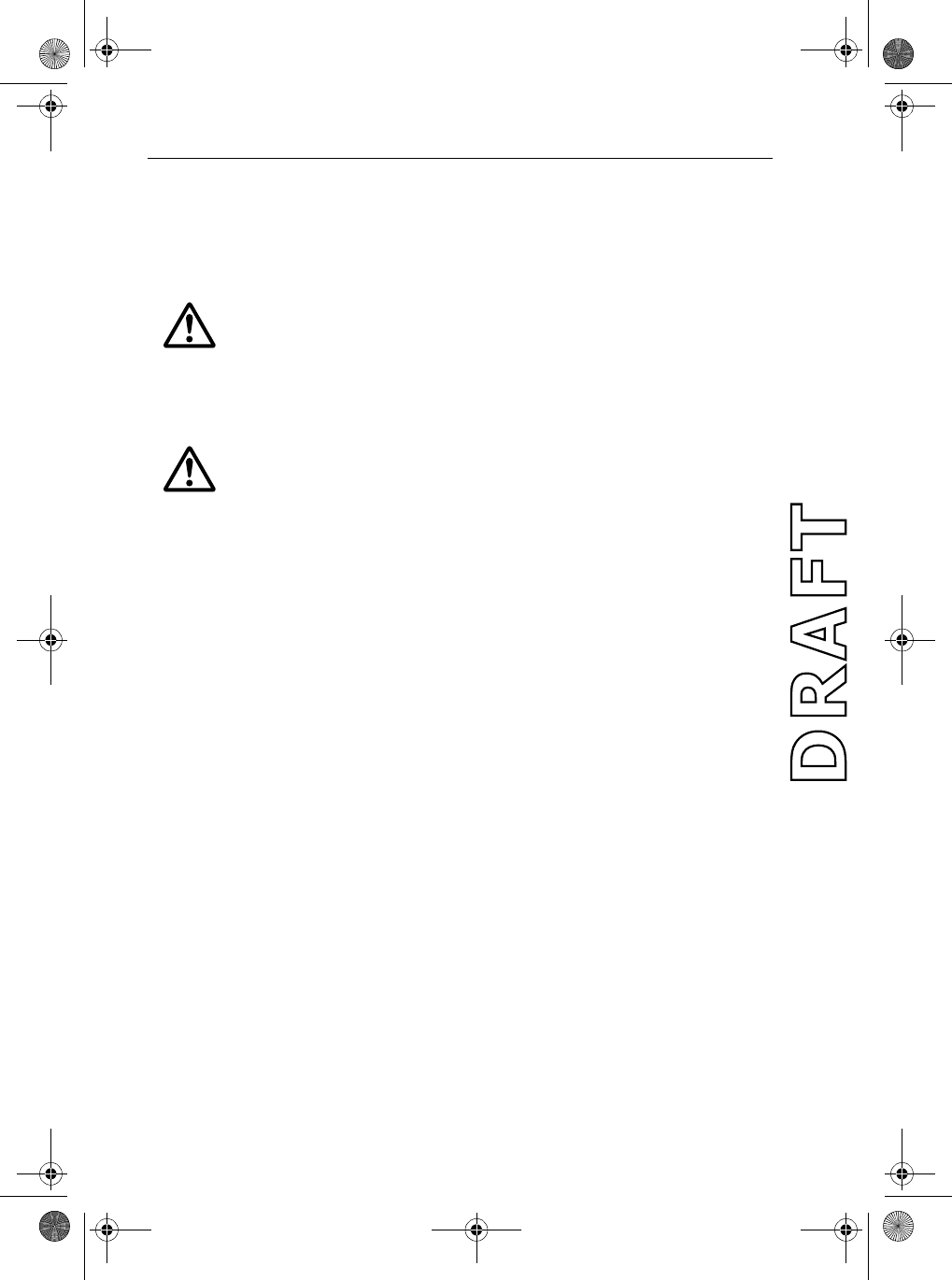
iv Ray101 Handheld VHF Radio
Important Information
Safety Warnings
WARNING: Navigation Aid
Although we have designed this product to be accurate and reliable,
many factors can affect its performance. As a result, it should only be
used as an aid to navigation and should never replace common sense and
navigational judgement. Always maintain a permanent watch so you
can respond to situations as they develop.
WARNING: Battery and Battery Charger Safety
Do not short the terminals in the charger base that recharge the
batteries.
Do not put the charger in water.
Do not charge the batteries with + and – terminals reversed.
Do not use charger if power plug or cable is damaged.
Do not recharge batteries if physically deformed or leaking.
EMC Conformance
All Raymarine equipment and accessories are designed to the best industry
standards for use in the recreational marine environment. Their design and
manufacture conform to the appropriate Electromagnetic Compatibility
(EMC) standards but correct installation and use is required to ensure that
performance is not compromised.
81229_1.book Page iv Wednesday, November 12, 2003 2:39 PM

v
Raymarine Products and Services
Raymarine products are supported by a network of Authorized Service
Representatives. Raymarine’s Technical Services representatives or your
local dealer will be available to answer any questions you may have. For
information on Raymarine products and services, contact either of the
following:
United States Raymarine, Inc.
22 Cotton Road, Unit D
Nashua, NH 03063-4219
USA
Telephone:1-603-881-5200
1-800-539-5539
Fax: 1-603-864-4756
Europe Raymarine Ltd
Anchorage Park
Portsmouth, Hampshire
England PO3 5TD
Telephone: +44 (0) 23 9269 3611
Fax: +44 (0) 23 9269 4642
Or, you may contact us on the World Wide Web at:
www.raymarine.com
Raymarine is a registered trademark of Raymarine Limited.
© Raymarine Limited 2003
81229_1.book Page v Wednesday, November 12, 2003 2:39 PM

vi Ray101 Handheld VHF Radio
81229_1.book Page vi Wednesday, November 12, 2003 2:39 PM

vii
Contents
Safety Warnings .......................................................................................iv
EMC Conformance .................................................................................iv
Chapter 1: General Information .........................................................................1
1.1 Introduction ...................................................................................... 1
1.2 Features ............................................................................................ 1
1.3 Licensing Requirements ................................................................... 2
Chapter 2: Installation .........................................................................................5
2.1 Unpacking and Inspection ................................................................ 5
Equipment Supplied .....................................................................5
2.2 Attaching the Antenna ...................................................................... 5
2.3 Attaching the Belt Clip ..................................................................... 6
2.4 Attaching the Wrist Strap ................................................................. 6
2.5 Battery Usage ................................................................................... 6
Battery Tray .................................................................................. 6
Charging Rechargeable NiMH Cells ........................................... 8
Chapter 3: Getting Started ..................................................................................9
3.1 Keypad and Rotary Knobs ............................................................... 9
Rotary Keys ..........................................................................10
Push Keys .............................................................................10
Description ................................................................................. 10
1. PWR/VOL ........................................................................10
2. SQ .....................................................................................10
3. PTT .................................................................................... 10
4. UP/DOWN ........................................................................ 11
5. Backlight / Keylock .......................................................... 11
6. 16/9 ................................................................................... 11
7. DW/TRI ............................................................................ 11
8. WX / BAND ...................................................................... 11
9. SCAN / SAVE ................................................................... 11
10. HL/USER ........................................................................ 11
3.2 LCD Display .................................................................................. 12
1. (TX) Transmitting ...................................................................12
2. (RX) Receiving ....................................................................... 12
3. (USER) Favorite Channel Mode .............................................12
4. (SAVED) Memory Mode ........................................................13
5. (PSCAN) All Scan/Saved Scan/Priority Scan ........................ 13
6. (U I C) Channel Set .................................................................13
7. (B) Receive-only Channel ...................................................... 13
8. (A) Simplex Channel ..............................................................13
81229_1.book Page vii Wednesday, November 12, 2003 2:39 PM

viii Ray101 Handheld VHF Radio
9 Channel Number ......................................................................13
10. Battery Level .........................................................................13
11. Keylock ................................................................................13
12. Indicators ..............................................................................14
13. Signal Strength ......................................................................14
Chapter 4: Operations ........................................................................................15
4.1 Turning the Power ON and OFF .....................................................15
4.2 Setting the Volume .........................................................................15
4.3 Setting the Squelch .........................................................................16
4.4 Setting the Power Output ................................................................16
Overriding the Low Output Power Restriction ...........................17
4.5 Setting the Channel ........................................................................17
4.6 Selecting a Weather Channel ..........................................................17
Weather Alert Operation .......................................................18
4.7 Setting the Frequency Band ...........................................................19
4.8 Selecting the Priority Channel ........................................................19
4.9 Selecting the Secondary Priority Channel ......................................20
Reprogramming the Secondary Priority Channel .......................20
4.10 Transmitting ...................................................................................21
4.11 Turning On the Backlight ...............................................................22
4.12 Turning On the Keylock .................................................................22
4.13 Using the Scan Modes ....................................................................23
All Scan .......................................................................................23
Saved (Memory) Scan ................................................................24
Priority All Scan ......................................................................... 25
Priority Saved Scan .....................................................................26
4.14 Adding Channels to Memory .........................................................27
4.15 Using the Monitor Modes ...............................................................28
Dual Watch ..................................................................................28
Tri Watch .....................................................................................29
4.16 USER Channel Mode .....................................................................30
4.17 Resetting Factory Defaults .............................................................31
Appendix A:Specifications .................................................................................33
Appendix B:Channel List .....................................................................................35
U.S. VHF Marine Radio Channels and Frequencies.................. 35
Canadian VHF Marine Radio Channels and Frequencies.......... 38
International VHF Marine Radio Channels & Frequencies ....... 43
Weather Channel (WX) Frequencies ..........................................46
Appendix C:Glossary ...........................................................................................47
Index ..................................................................................................49
81229_1.book Page viii Wednesday, November 12, 2003 2:39 PM
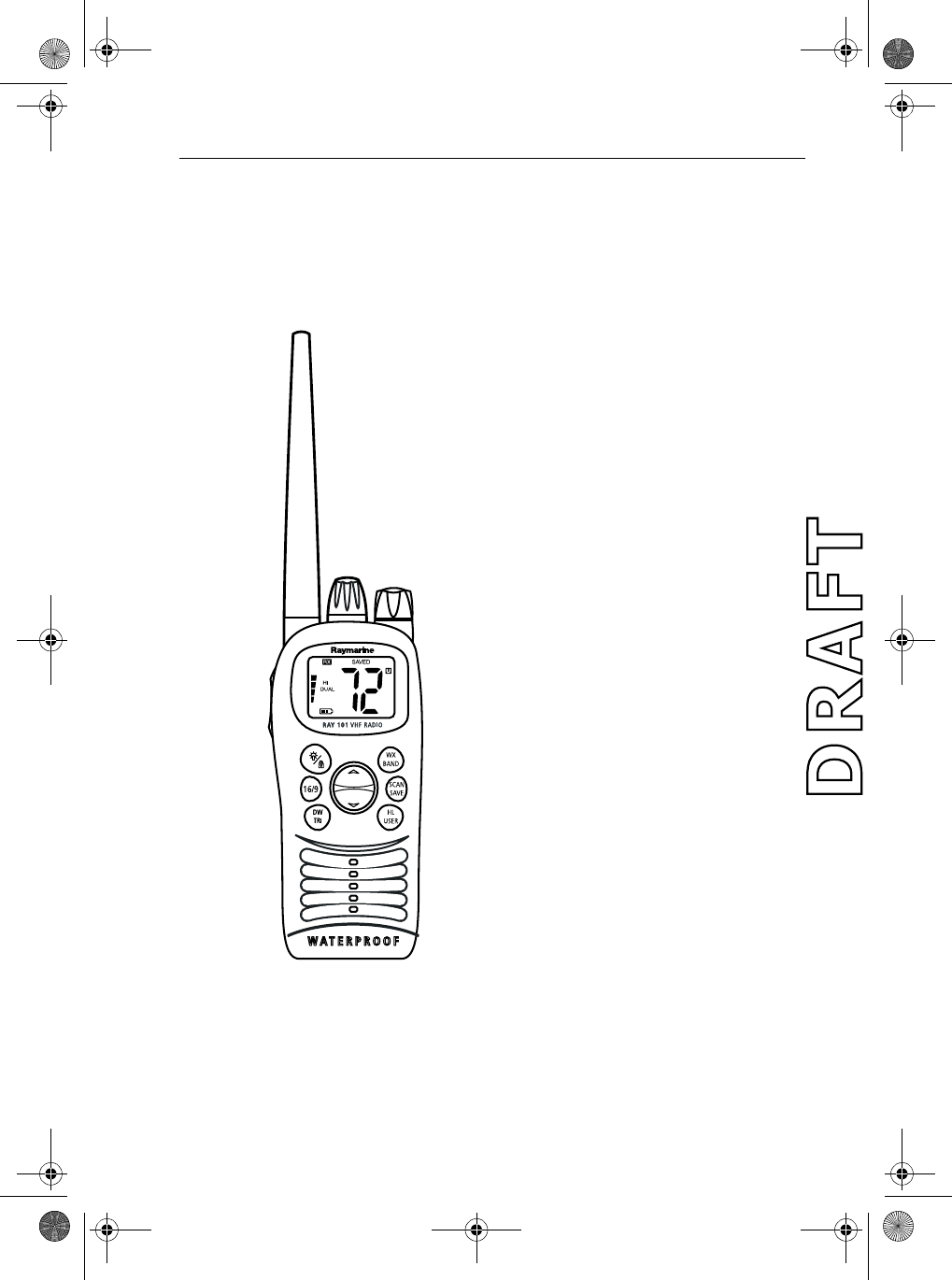
Chapter 1: General Information 1
Chapter 1: General Information
1.1 Introduction
The Ray101 is a microprocessor-controlled,
portable transceiver that provides reliable simplex
(single frequency) and semi-duplex (two
frequency) communications. This handbook
describes the physical and functional
characteristics of the radio.
The Ray101 provides two-way communications
on all US, Canadian and International marine
channels and ten weather channels. Refer to the
Frequency Tables in Appendix B, which list all
marine VHF channels available in your radio.
You should familiarize yourself with these tables
as you are responsible for using the proper
channels.
1.2Features
The Ray101 is designed and manufactured to
provide ease of operation with excellent
reliability. The Ray101 features:
•Waterproof to IPX-7 standard
•Saved-channels Scan and Priority Scan
•Dual/Tri Watch Monitor modes
•Dedicated key for switching to Channel 16
•10 Weather Channels
•Programmable Secondary Priority channel key
•NiMH batteries (AA size) included
•NiMH Quick Charger included
•12VDC Cigarette Lighter Adapter included
81229_1.book Page 1 Wednesday, November 12, 2003 2:39 PM

2 Ray101 Handheld VHF Radio
1.3 Licensing Requirements
Raymarine radios comply with the Federal Communications Commission
(FCC) and Industry Canada requirements that regulate marine VHF radio
usage for the US and Canada, respectively. Marine VHF radio users in the US
must comply with all applicable FCC rules and regulations, some of which
are described here and in Section 5.
This information was current at the time this handbook was printed. Up-to-
date information, including licensing requirements, can be obtained on the
FCC website at:
www.fcc.gov/wtb/marine
Official FCC forms can be obtained on the FCC website at:
www.fcc.gov/formpage.html
FCC Notice
This device complies with Parts 15 and 80 of the FCC Rules. Operation is
subject to the conditions that this device does not cause harmful
interference. Changes or modifications to this equipment not expressly
approved in writing by Raymarine, Incorporated could violate compliance
with FCC rules and void the operator’s authority to operate the equipment.
Station License
An FCC Ship Radio Station License and Call Sign are not required for most
recreational vessels travelling in US waters. Examples of radio equipment
that do not require a license include: marine VHF radios, any type of
Emergency Position Indicating Radio Beacon (EPIRB), any type of radar,
GPS or LORAN receivers, depth finders, CB radio, or amateur radio (an
amateur license is required). However, you must obtain a license if: (1) you
are required by law or treaty to carry a radio on your vessel; (2) your vessel
travels to foreign ports; (3) you use marine radio equipment on board your
vessel other than the devices listed above. Ships that use MF/HF single side-
band radio, satellite communications, or telegraphy must be licensed by the
FCC. If necessary, you can obtain a Station License by filing FCC Form 605,
which is available from the FCC website listed above.
81229_1.book Page 2 Wednesday, November 12, 2003 2:39 PM

Chapter 1: General Information 3
Operator License
An Operator License is not required to operate a VHF Marine Radio within
US territorial waters. However, a license is required to operate the radio if
you dock in a foreign port (including Canada and Mexico) or leave a foreign
port to dock in a U.S. port. You can request a Restricted Radiotelephone
Operator Permit from the FCC by filing Form 753.
INDUSTRY CANADA
You do not need a license to operate this radio within sovereign waters of
Canada or the US. You will need a license to operate this radio outside of
Canada or the US. To obtain Industry Canada licensing information, contact
the nearest field or regional office, or write:
Industry Canada
Radio Regulatory Branch
Attention: DOSP
300 Slater Street
Ottawa, Ontario
Canada, KIA OC8
The following information about the radio is required to complete the
license application:
Industry Canada Certification Number 4069823227AD-----------------
FCC Type Number PJ5RAY230--------------------------
FCC Type Accepted Parts 15 and 80------------------
Output Power 1 watt (low) & 25 watts (high)-----------------
Modulation 16FE (FM)----------------------------
Frequency Range 156.025-157.425-----------------------
81229_1.book Page 3 Wednesday, November 12, 2003 2:39 PM

4 Ray101 Handheld VHF Radio
81229_1.book Page 4 Wednesday, November 12, 2003 2:39 PM

Chapter 2: Installation 5
Chapter 2: Installation
2.1 Unpacking and Inspection
Use care when unpacking the unit from the shipping carton to prevent
damage to the contents. It is also good practice to save the carton and the
interior packing material in the event you must return the unit to the factory.
Equipment Supplied
The following is a list of materials supplied with the Ray101:
1 Only connect Cigarette Lighter Adapter to 12VDC system. Connecting to other voltage systems
can damage the charger.
2.2 Attaching the Antenna
Rotate the antenna clockwise to securely fasten it to the threaded connector
on the top of the radio.
Note: Do not operate the radio or press PTT without an antenna attached.
Table 2-1: Supplied Components
Part Number Description
E43026 RAY101 Handheld VHF Radio
81229 Ray101 Handbook
—Antenna
—Battery Tray
—NiMH Quick Charger
—12VDC Cigarette Lighter Adapter 1
—Batteries, (6) AA NiMH (1300mAh)
—Wrist Strap
—Belt Clip
81229_1.book Page 5 Wednesday, November 12, 2003 2:39 PM

6 Ray101 Handheld VHF Radio
2.3 Attaching the Belt Clip
➤To attach the belt clip and adapter:
1. Remove the belt clip and adapter hardware from the packing materials.
2. With the adapter button facing away from the Ray101, slide the adapter
into the notch on the rear of the radio until it snaps into place.
3. Hold the belt clip perpendicular to the Ray101 and slide the belt clip
notch onto the adapter button until it snaps into place.
4. Rotate the belt clip so that the longer end extends above the top of the
radio.
5. Squeeze together the two top ends of the belt clip and attach to your belt
or pant waist.
➤To remove the radio from the belt clip:
1. Rotate the radio perpendicular to the belt clip.
2. Press the release button at the top of the belt clip.
3. Pull the radio up and away from the belt clip.
2.4 Attaching the Wrist Strap
1. Feed the narrow end of the strap through the two mounting holes at the
top of the radio behind the antenna.
2. Continue feeding the narrow end of the strap through the loop and pull
tight.
2.5 Battery Usage
The Ray101 can be powered by the supplied six (6) Nickel Metal Hydride
(NiMH) batteries or with six (6) regular AA alkaline cells (not supplied),
using the supplied Battery Tray.
Battery Tray
➤To open the Battery Tray and insert the battery cells:
1. Using a coin or flat blade screwdriver, turn the screw at the base of the
unit counterclockwise1/4 turn to the UNLOCK position.
2. While holding the Ray101 in one hand, use the other hand to push the bat-
tery tray downward and then away to separate it from the back of the
radio.
81229_1.book Page 6 Wednesday, November 12, 2003 2:39 PM
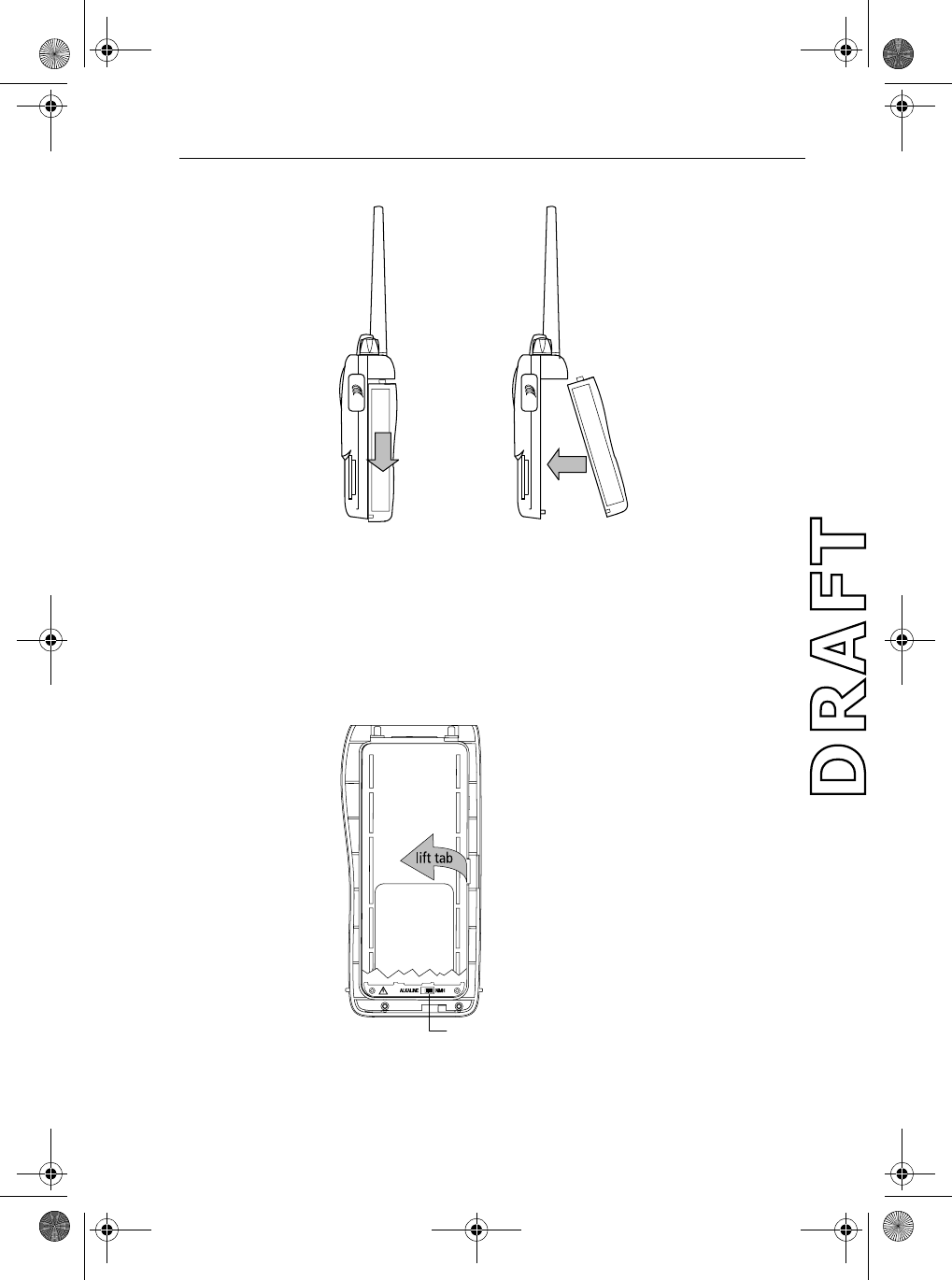
Chapter 2: Installation 7
Figure 2-1: Removing and Attaching the Battery Tray
3. Lift up the tab located on the center right side of the battery tray cover
and remove it from the battery tray.
4. Locate the Battery Type switch just below the battery compartment and
turn to the appropriate position: ALKALINE or NiMH.
Figure 2-2: Removing the Battery Tray Cover
Remove Attach
Battery Type Switch
(under batery cover)
81229_1.book Page 7 Wednesday, November 12, 2003 2:39 PM
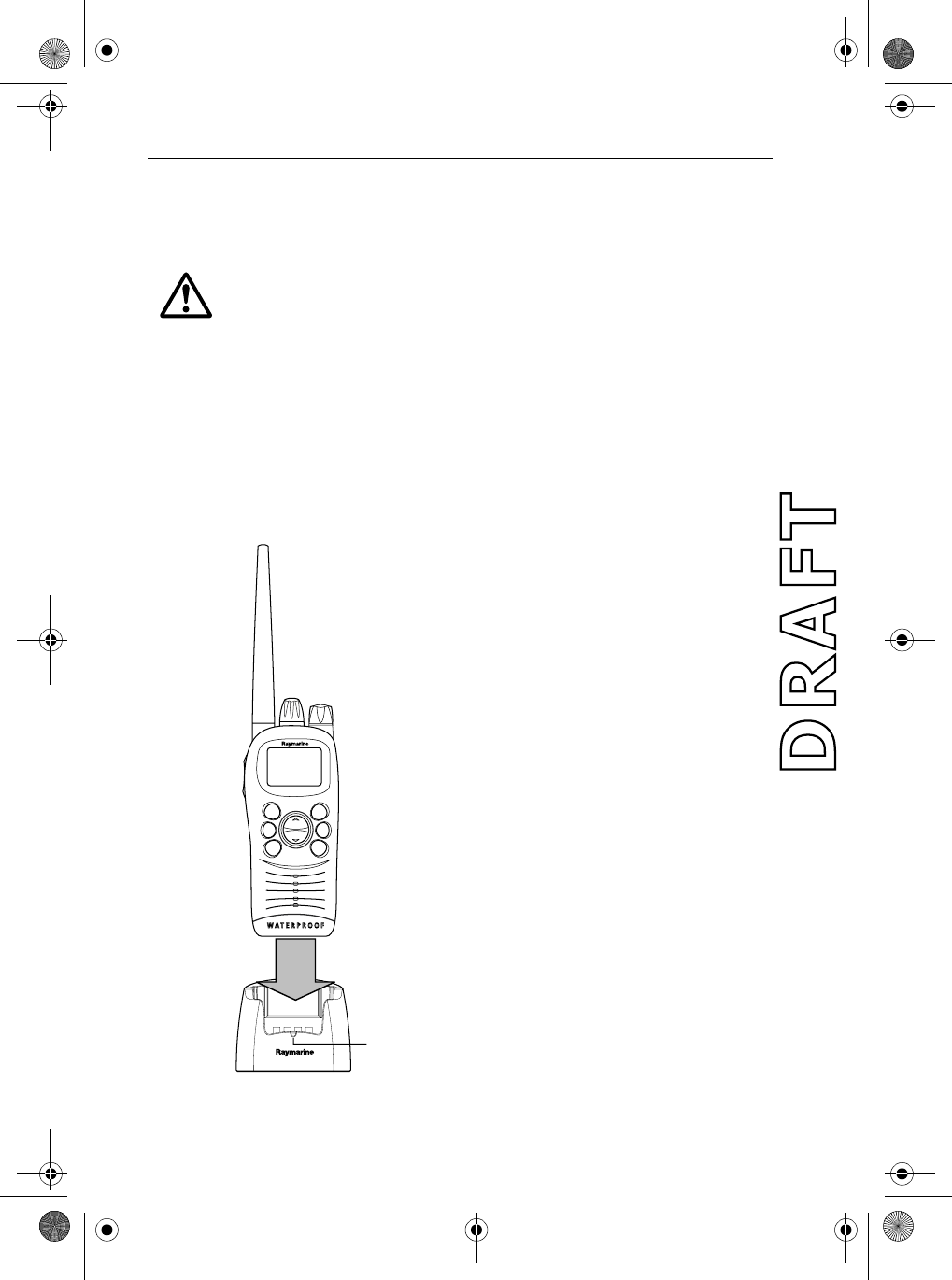
8 Ray101 Handheld VHF Radio
5. Noting the proper orientation, install the AA cells in three rows of two
batteries each.
6. Replace the battery tray cover.
WARNING:
Be sure to set the Battery Type switch to the ALKALINE position before
operating the radio with alkaline batteries. Operating the radio with
alkaline batteries when the Battery Type switch is set to NiMH can cause
battery leakage or explosion resulting in damage or injury.
7. Slide the battery tray up into the rear of the radio and then downward until
it snaps into place.
8. Turn the screw at the base of the battery case clockwise to the LOCK
position.
Charging Rechargeable NiMH Cells
The NiMH batteries must be fully charged
before use. To charge the batteries:
1.Insert the radio with the battery tray attached
into the NiMH charger unit.
2.Connect the AC wall adapter into a standard
wall outlet.
or
Connect the Cigarette Lighter Adapter into a
standard 12VDC Cigarette Lighter.
3.Insert the molded plug into the connector on
the side of the battery charger.
The CHARGE indicator LED on the front of the
charger lights when it is receiving voltage from
the AC adapter.
RED means the batteries are charging.
GREEN means the batteries are fully charged.
Initial charging will complete in approximately 8
hours. Typical time for recharging is 3 to 5 hours.
CAUTION:
1.Make sure the switch just below the battery
compartment is set to the NiMH position.
2.Please follow the Battery Safety rules out-
lined at the front of this handbook.
LED
81229_1.book Page 8 Wednesday, November 12, 2003 2:39 PM
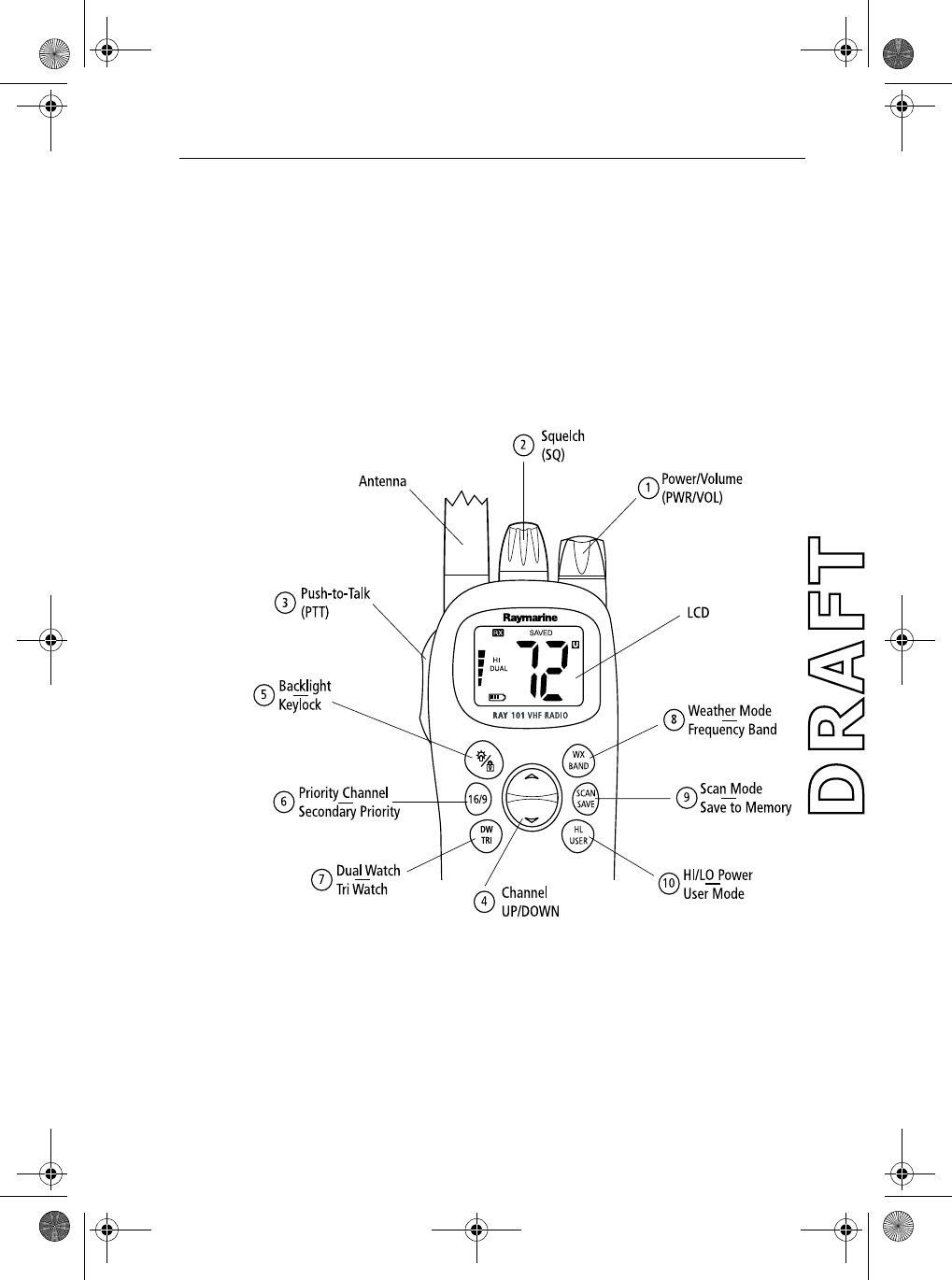
Chapter 3: Getting Started 9
Chapter 3: Getting Started
3.1 Keypad and Rotary Knobs
Several of the keys on the front panel of the base station serve multiple
purposes. For the most part, the function indicated on the first line of the key
is accessed by pressing and releasing that key. The function indicated on the
second line of the key is accessed by pressing and holding the key for three
seconds.
Figure 3-1: Ray101 Keys Layout
81229_1.book Page 9 Wednesday, November 12, 2003 2:39 PM
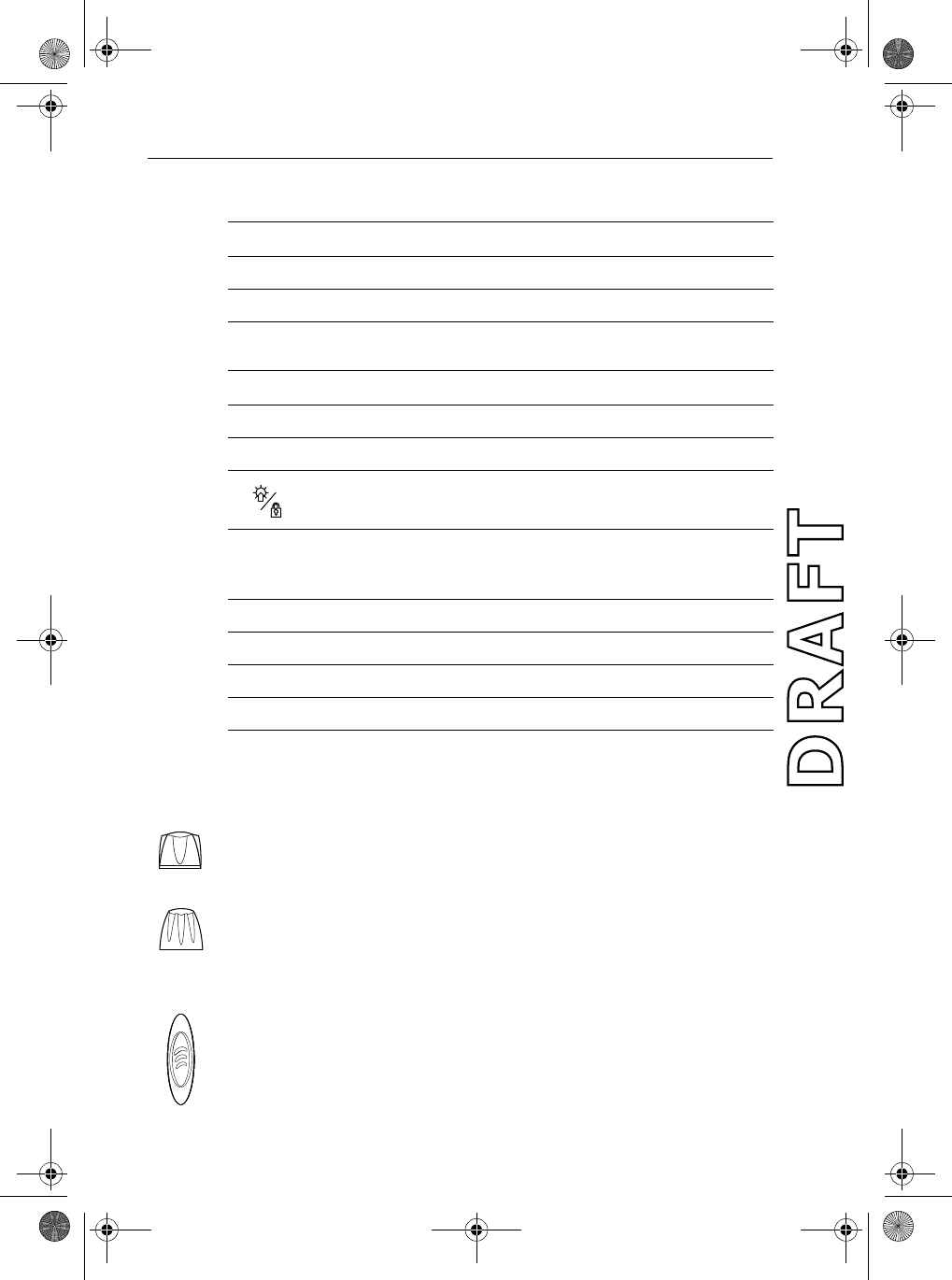
10 Ray101 Handheld VHF Radio
Rotary Keys
Push Keys
Description
1. PWR/VOL
Use this knob to turn the radio ON and OFF and to set the volume.
2. SQ
Use this knob to set the squelch threshold, which cuts off the receiver when
the signal is too weak for reception of anything but noise.
3. PTT
While pressing this Press-to-Talk key radio transmission is enabled.
Key Name Function
1. PWR/VOL Power radio ON / OFF and adjust volume level
2. SQ Adjust squelch threshold level
Key Name Press & Release (<3 sec) Press & Hold(>3 sec)
3. PTT Press-to-talk Press-to-talk
4. UP/DOWN Channel increment/decrement Rapid channel change
5.
Backlight ON/OFF Keylock ON/OFF
6. 16/9 Switches between the Priority
and Working Channels Switches to secondary Priority CH (9);
If already tuned to secondary channel,
programs a new secondary Priority Channel.
7. DW/TRI Dual Watch Mode Tri Watch Mode
8. WX/BAND Weather Channel Mode Select frequency band
9. SCAN/SAVE Scan ON/OFF SAVE/DELETE channel to/from memory
10. HL/USER TX Power High/Low USER (Saved Memory Channel) Mode
81229_1.book Page 10 Wednesday, November 12, 2003 2:39 PM
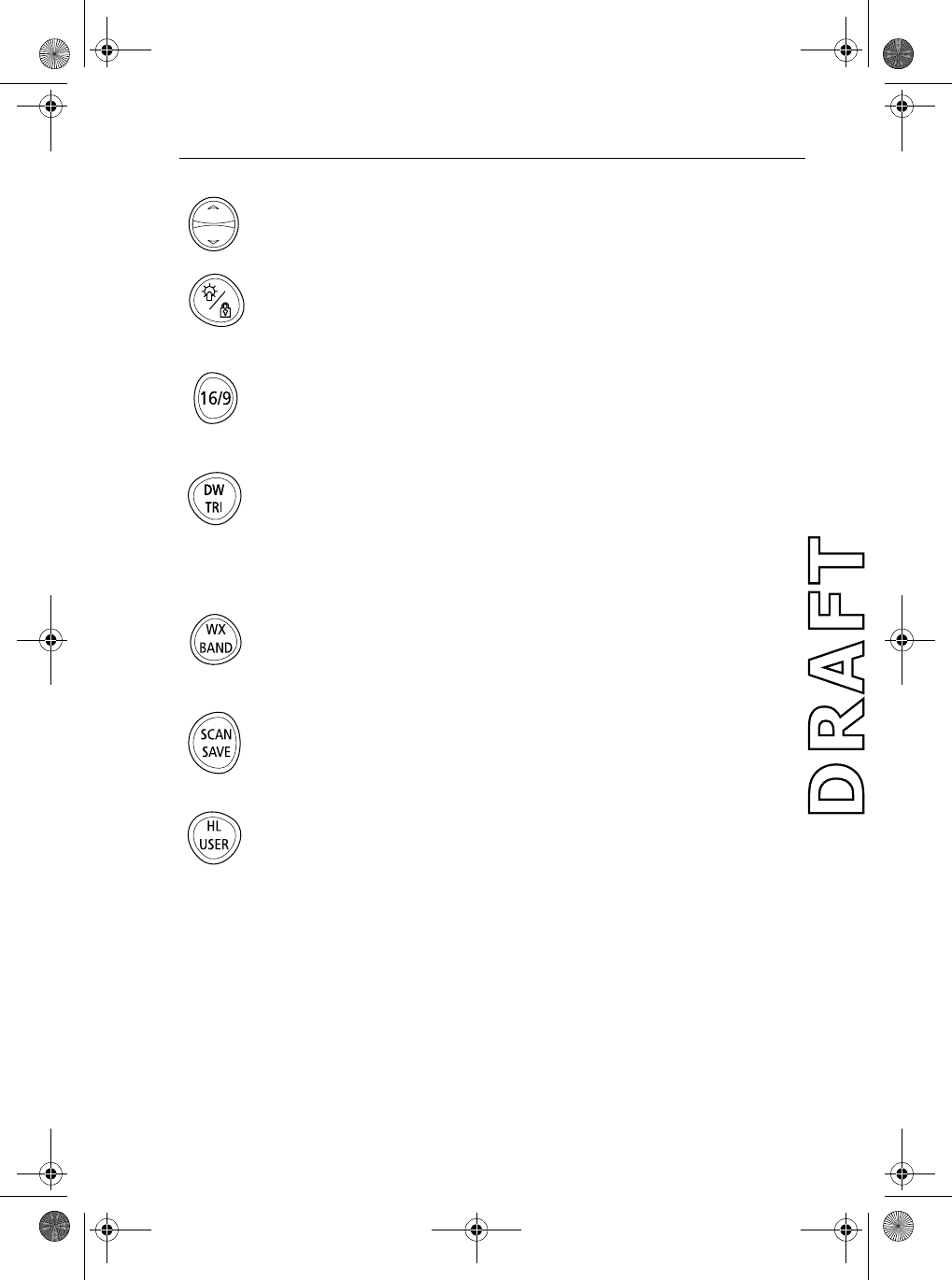
Chapter 3: Getting Started 11
4. UP/DOWN
Use the arrow keys to change the current channel number.
5. Backlight / Keylock
Use this key to toggle ON or OFF the display’s backlight and the keylock
function, which protects the radio from any keypad entry.
6. 16/9
Use this key to switch to the priority channel or to change the value of the
Secondary Priority Channel.
7. DW/TRI
Use this key to select either the Dual Watch or Tri Watch modes. Dual Watch
monitors the current working channel and CH 16 in cycle. Tri Watch
monitors CH 16, the current working channel and the channel you have set
as the Secondary Priority Channel in cycle.
8. WX / BAND
Use this key to select the Weather mode or to alternate the frequency band
between the USA, International and Canadian channel sets.
9. SCAN / SAVE
Use this key to enter a Scan Mode or to enter a channel into the radio’s
memory.
10. HL/USER
Use this key to toggle the transmit power from HIGH to LOW and to enter
User Channel Mode, which displays only the channels that you have saved to
memory.
81229_1.book Page 11 Wednesday, November 12, 2003 2:39 PM
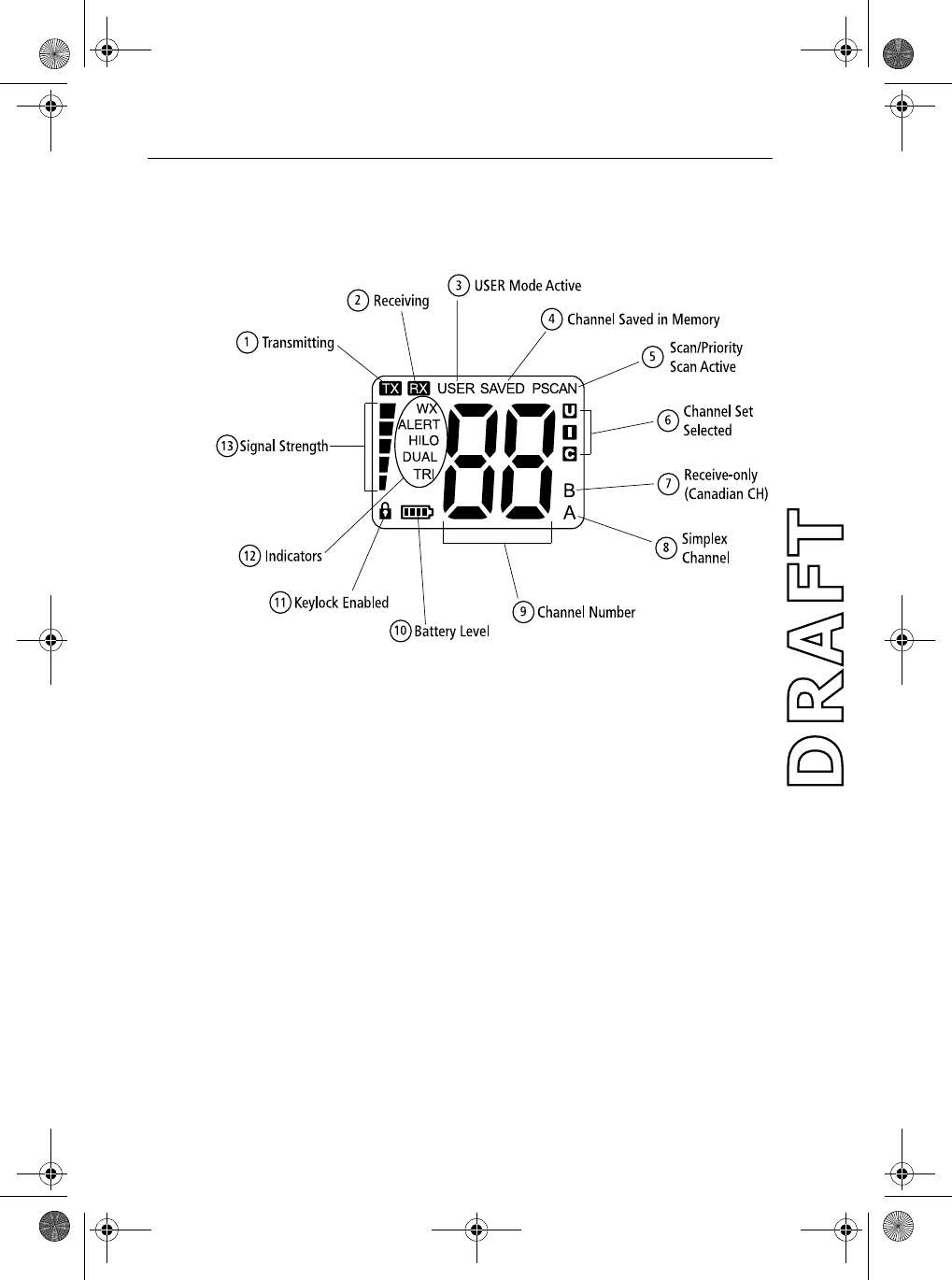
12 Ray101 Handheld VHF Radio
3.2 LCD Display
The following describes the functional characters on the Ray101’s LCD.
Figure 3-2: Ray101 LCD Layout
1. (TX) Transmitting
Indicates the PTT is being depressed and the radio is transmitting.
2. (RX) Receiving
Indicates that the radio is receiving a radio signal.If the radio receives a signal
but the squelch threshold is set so high that the signal cannot be heard, the RX
indicator is not displayed but the bar graph on the left side of the LCD is
illuminated to show the appropriate signal strength.
3. (USER) Favorite Channel Mode
Indicates the radio is in USER Mode. USER Mode displays only the
channels that you have saved to memory, enabling you to easily scan your
favorite channels while bypassing unwanted or seldom-used channels.
81229_1.book Page 12 Wednesday, November 12, 2003 2:39 PM
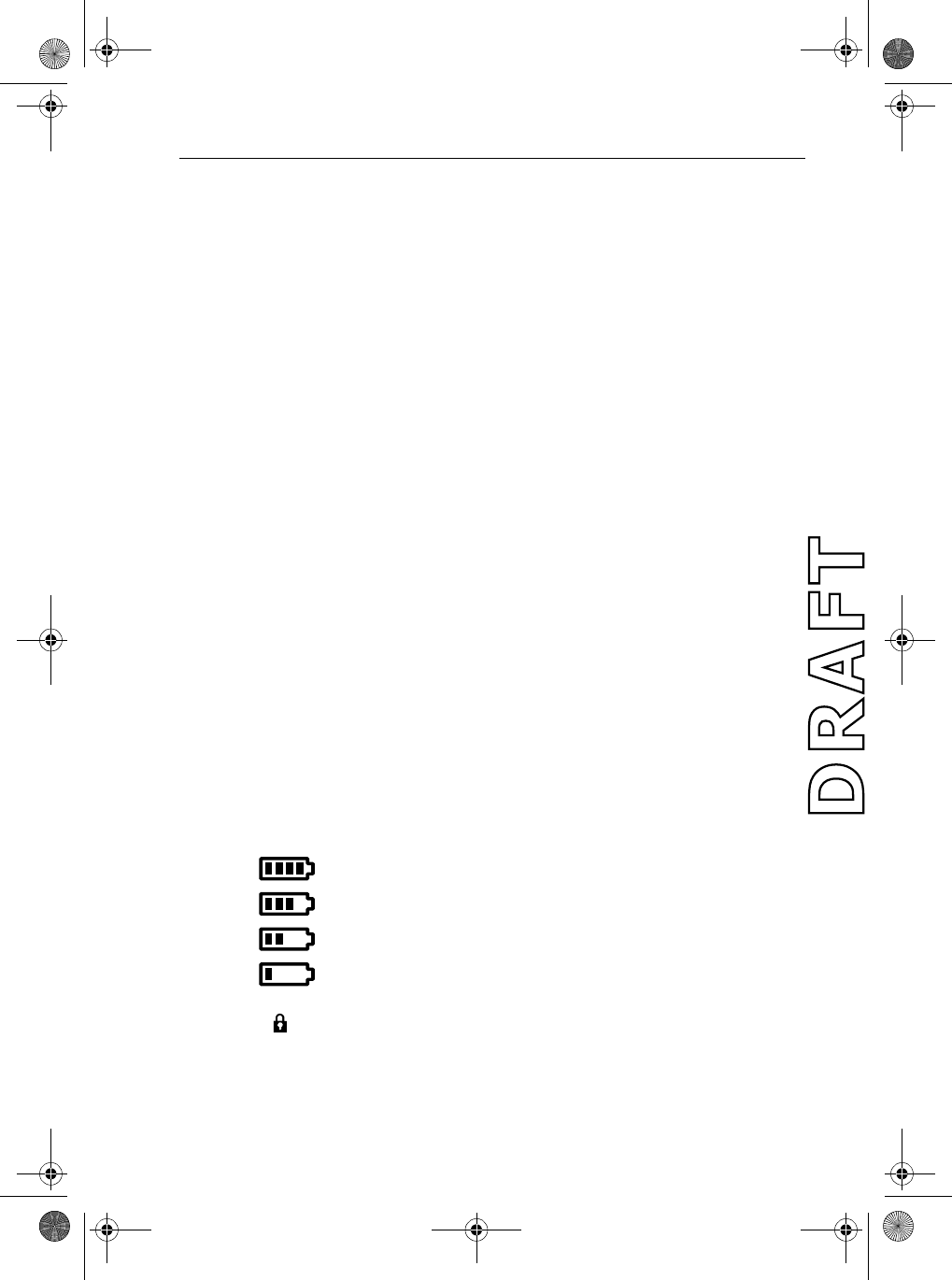
Chapter 3: Getting Started 13
4. (SAVED) Memory Mode
Indicates the current channel has been saved in memory. Appears during
Saved Scan mode. Only saved channels are scanned during USER mode.
5. (PSCAN) All Scan/Saved Scan/Priority Scan
PSCAN appears during Priority Scan mode. SCAN appears during All Scan
and Saved Scan. (SAVED also appears during Saved Scan mode.)
6. (U I C) Channel Set
Indicates which channel set is currently selected: US, International or
Canadian.
7. (B) Receive-only Channel
Indicates that you cannot transmit on the currently-selected channel; it is
receive-only. Used with Canadian channels only.
8. (A) Simplex Channel
Indicates that the currently-selected channel is simplex; you transmit and
receive on the same frequency.
9 Channel Number
Displays the current channel number.
10. Battery Level
Indicates current battery strength. Greater battery strength displays a larger
number of segments in the bar graph.
11. Keylock
Indicates the radio is protected from any keypad entry except for PTT and the
backlight function.
Fully charged
Normal operation
Normal operation
Needs charging
81229_1.book Page 13 Wednesday, November 12, 2003 2:39 PM
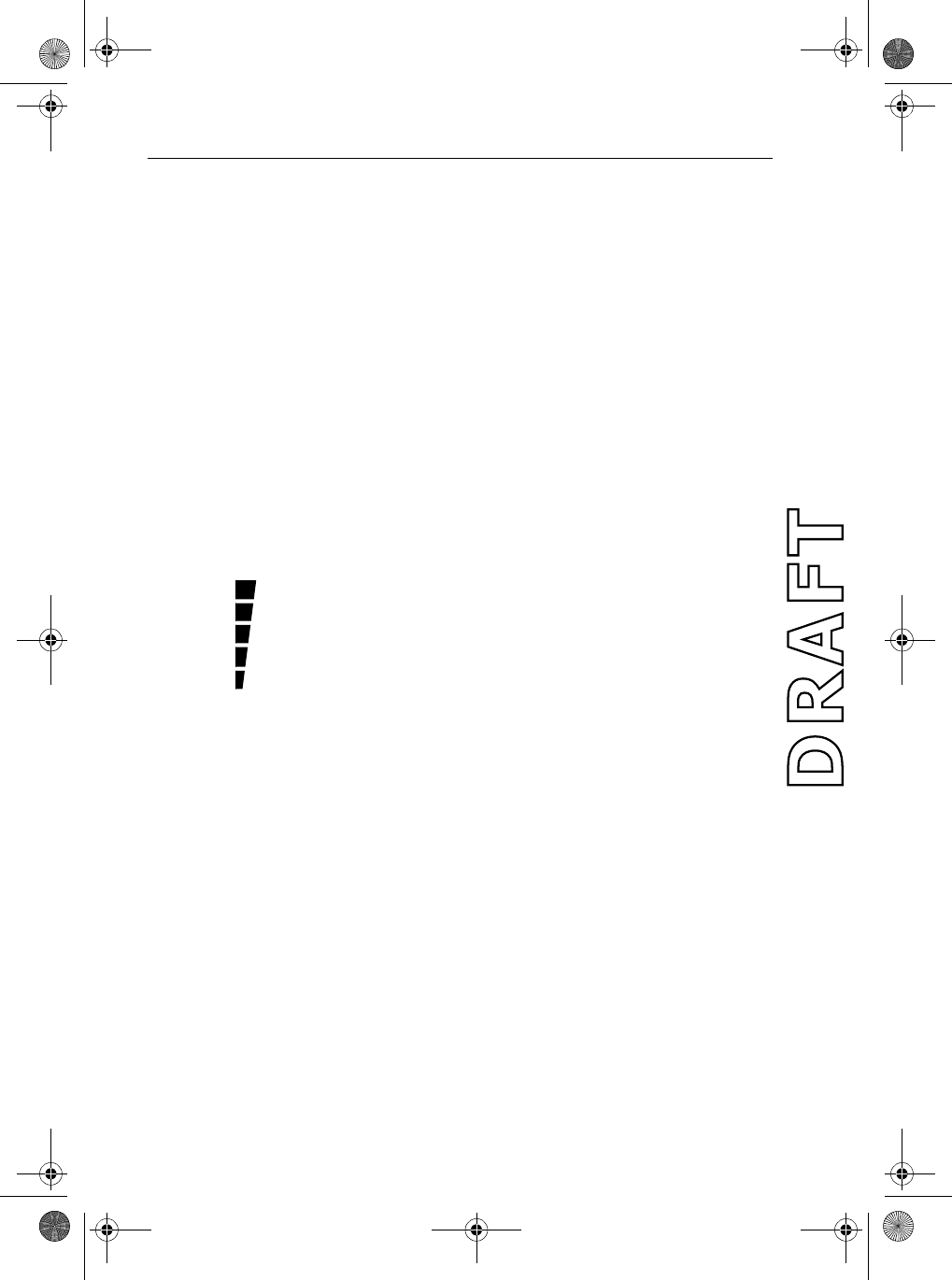
14 Ray101 Handheld VHF Radio
12. Indicators
Indicates special conditions:
(WX) Weather Channel
Weather channel mode is active. US and Canada only.
(ALERT) Weather Alert
A weather alert is being received. US and Canada only.
(HI/LO) TX Power
Indicates whether transmit power is set for 5 watts (HI) or 1 watt (LO).
(DUAL) Dual Watch
Indicates the radio is in Dual Watch mode.
(TRI) Tri Watch
Indicates the radio is in Tri Watch mode.
13. Signal Strength
Displays the relative strength of the TX and RX signals.
When transmit output power is set for 1 watt, only two bars are
displayed.
When the output power is set for 5 watts, the full scale (5 bars) is
displayed.
When receiving, the bar graph indicates the strength of the signal being
received. A stronger signal displays a larger number of segments in the bar
graph.
81229_1.book Page 14 Wednesday, November 12, 2003 2:39 PM
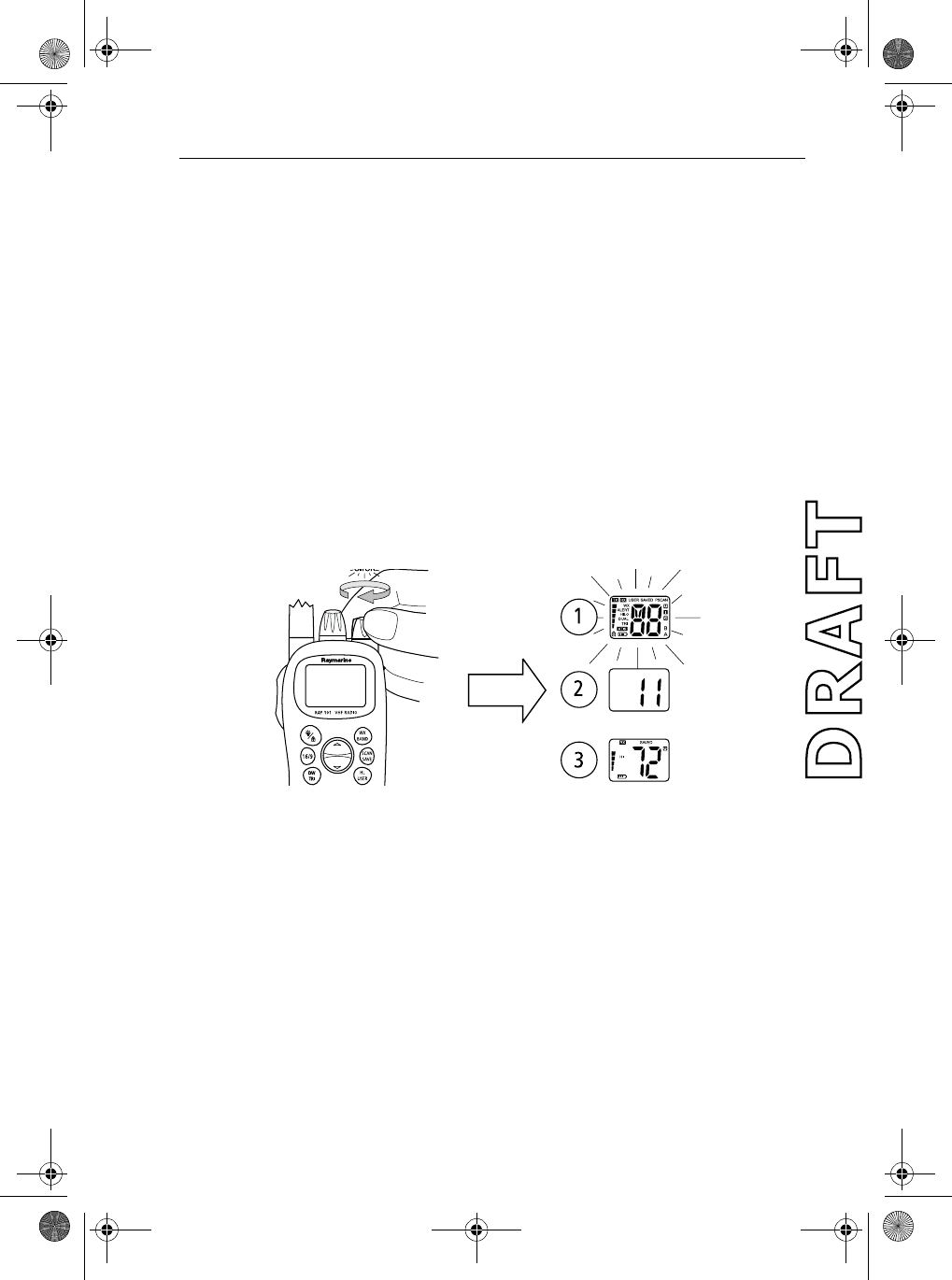
Chapter 4: Operations 15
Chapter 4: Operations
4.1 Turning the Power ON and OFF
Turn the PWR/VOL knob clockwise until it clicks.
When the unit powers up in Normal mode it:
1. Beeps, illuminates the backlight at full brightness, and displays all seg-
ments and indicators for 2 seconds.
2. Displays the software version number on the LCD but without the deci-
mal point. For example, version 1.1 would appear as 11.
3. Recalls the last CH number, TX power settings and operation mode.
If no last-used setting data exists, goes to CH 16 and high TX Power.
➤To turn the unit OFF:
Rotate the Volume knob completely counterclockwise until it clicks.
4.2 Setting the Volume
Adjust the PWR/VOL knob to control the loudspeaker volume level. Turn
clockwise to increase the volume; counterclockwise to decrease the volume.
Note: Key press beep volume is also controlled by the VOL level.
81229_1.book Page 15 Wednesday, November 12, 2003 2:39 PM
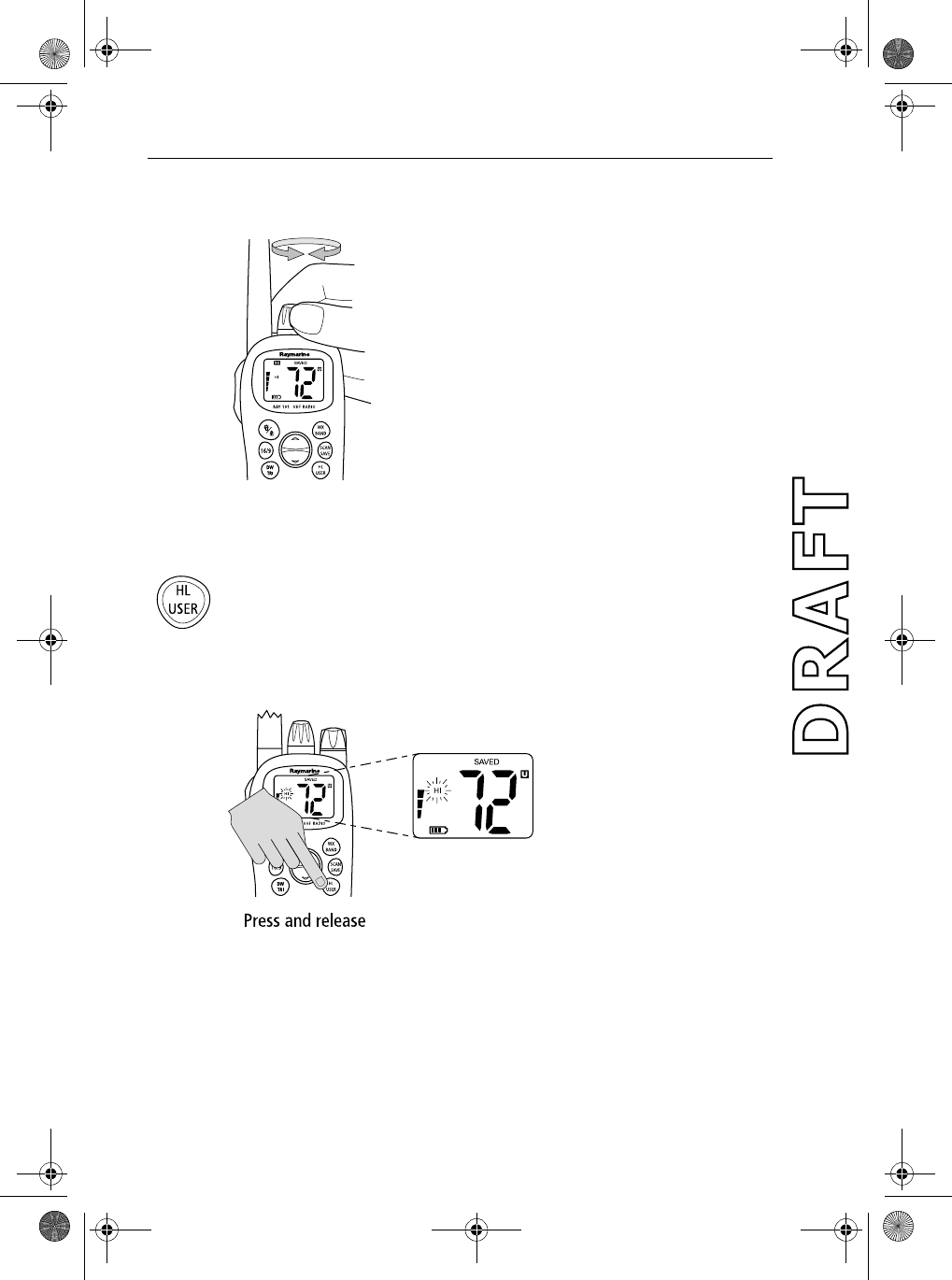
16 Ray101 Handheld VHF Radio
4.3 Setting the Squelch
The Squelch circuit sets the threshold for cutting off
the receiver when the signal is too weak for reception
of anything but noise.
To properly set the squelch, rotate the SQ knob
counterclockwise until audio is heard.
Then rotate clockwise until background noise
disappears.
4.4 Setting the Power Output
The choice of power output is dependent upon the distance of transmission
and transmitting conditions.
Press and release the HL/USER key to toggle the TX power from LOW (1
watt to HIGH (5 watts). The corresponding LO or HI indicator appears on the
LCD.
Note: Some channels are limited by regulation to be low power only. If the
HILO operation request is denied, an error tone beeps.
81229_1.book Page 16 Wednesday, November 12, 2003 2:39 PM
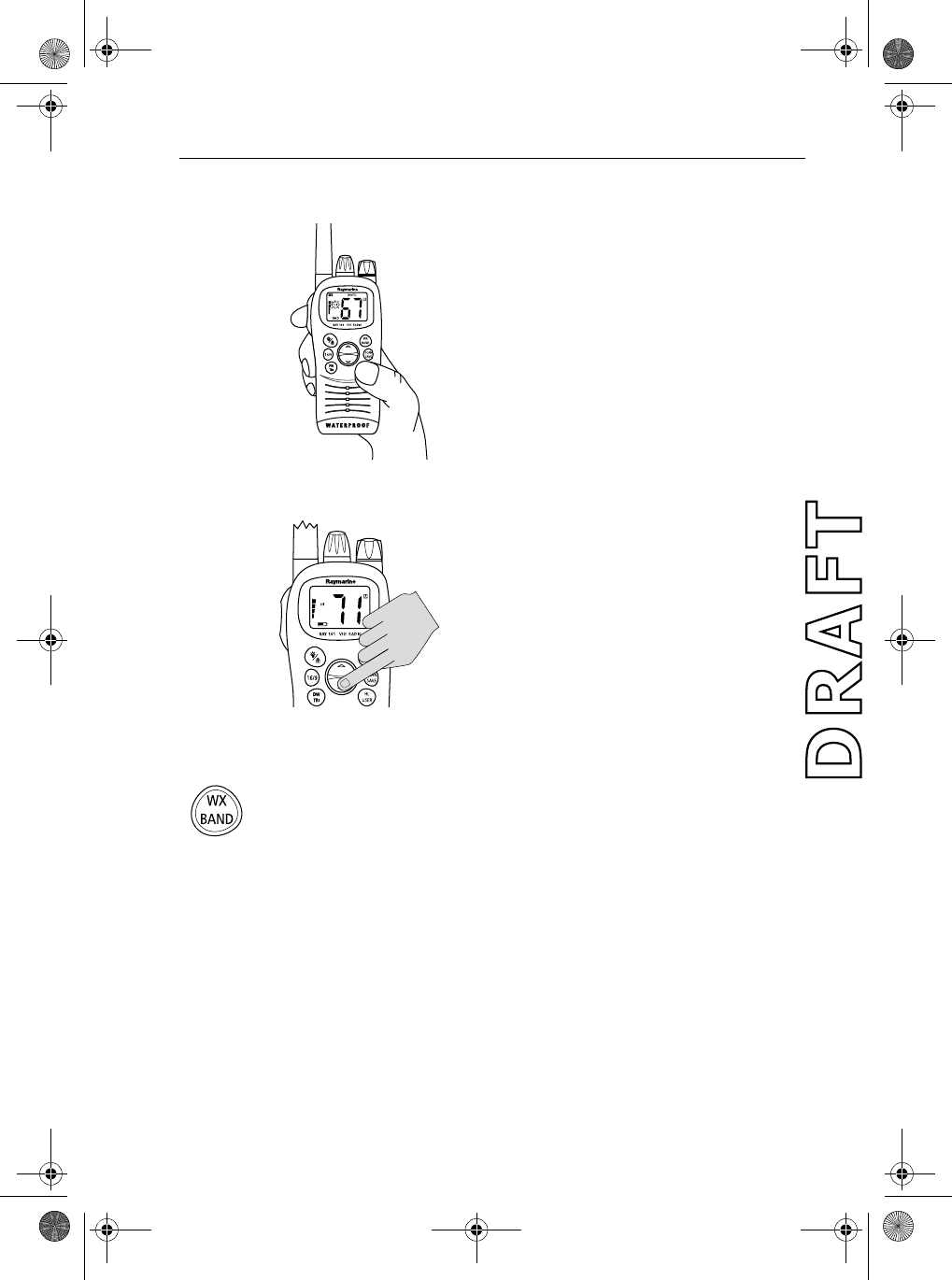
Chapter 4: Operations 17
Overriding the Low Output Power Restriction
In the US, channels 13 and 67 can temporarily
override the low power restriction.
➤To override the LO power restriction on
channels 13 or 67 and transmit at high power:
Press and hold and hold the HL/USER key as
you press and hold the PTT key. The TX power is
set to HI power for as long as you hold down
both keys.
4.5 Setting the Channel
Press and release the UP arrow to increment
the channel number.
Press and release the DOWN arrow to
decrement the channel.
Press and hold either key for rapid channel
scrolling.
4.6 Selecting a Weather Channel
The US National Oceanic and Atmospheric Administration (NOAA)
broadcasts continuous weather reports and severe weather alerts, as needed.
The Ray101 is programmed to receive10 NOAA weather channels and
sound an alarm if a weather alert is received.
Press and release the WX/BAND key to enter Weather mode. The WX
indicator appears.
Press Channel UP/DOWN to change the WX channel 0 through Channel 9.
81229_1.book Page 17 Wednesday, November 12, 2003 2:39 PM
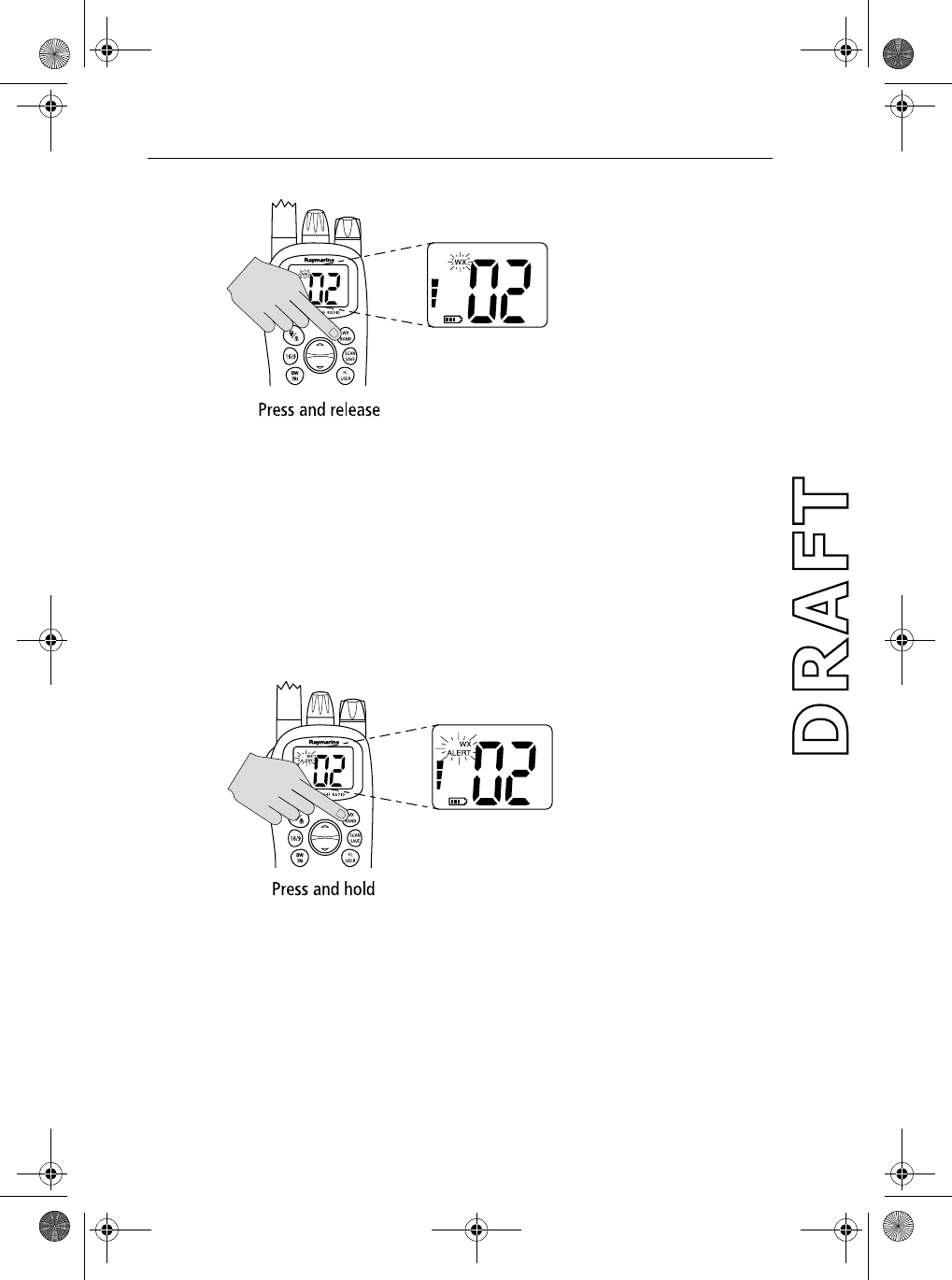
18 Ray101 Handheld VHF Radio
Press and release the WX/BAND key again to return to normal operation.
Note:
1. Weather broadcasts can only be heard in the US and Canada.
2. During Weather mode, the PTT, SCAN/SAVE, DW/TRI and HL/USER
keys are disabled and an error beep sounds if pressed.
Weather Alert Operation
Weather Alert is toggled ON and OFF by pressing and holding WX/BAND
button in the weather mode. The ALERT icon illuminates.
When Weather Alert function is enabled and the radio is tuned to the normal
working channel, the last-used weather channel is checked every 30 seconds
for weather alert tone. If the alert tone is detected, the WX and ALERT
indicators flash and a short alarm tone sounds.
The radio automatically turns to the currently-monitored WX channel where
the weather alert has been detected. The alert is detected in all modes of
operation (Standby, Dual and Tri Watch, Scan, etc.)
81229_1.book Page 18 Wednesday, November 12, 2003 2:39 PM
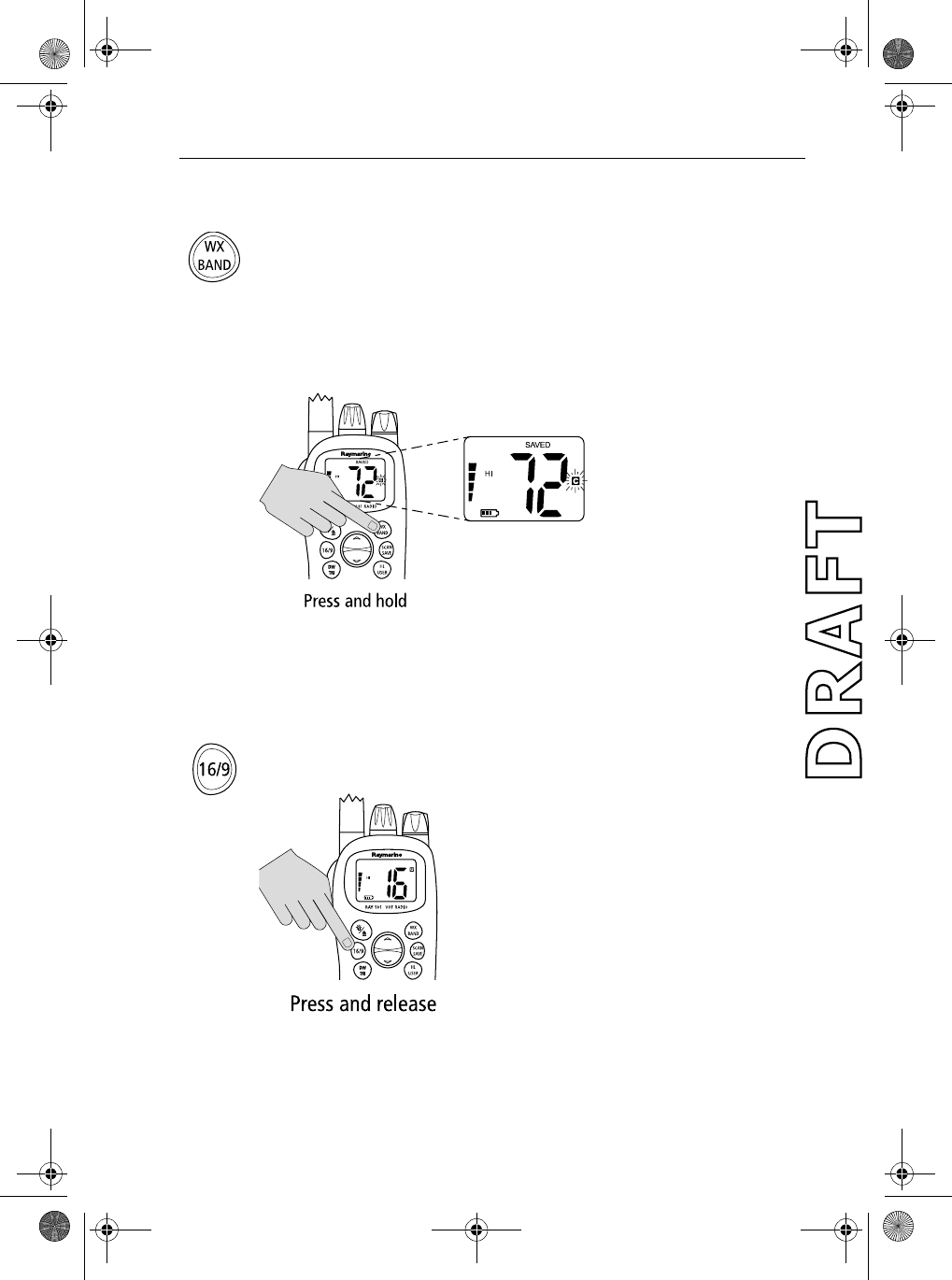
Chapter 4: Operations 19
4.7 Setting the Frequency Band
The Ray101 can transmit and receive on all available US, Canadian and
International marine VHF radiotelephone channels.
Press and hold the WX/BAND key for greater than 3 seconds while in
normal operation mode to alternate between the International, US and
Canadian channel sets. The appropriate indicator is illuminated in the LCD:
U for US, I for International, or C for Canadian channel sets.
Note: Pressing and holding the WX/BAND key for greater than 3 seconds
while in Weather mode toggles the Weather Alert mode.
4.8 Selecting the Priority Channel
The Ray101E provides you with a dedicated key for switching to the
Priority Channel 16.
If not already tuned to the Priority Channel 16,
press and release the 16/9 key to switch to
CH16 at high power.
If already on CH 16, press and release the 16/9
to return to the last-used working channel.
Note: When you press the 16/9 key, the radio al-
ways switches to HIGH power. You can use the
HL/USER key to change to LOW power.
81229_1.book Page 19 Wednesday, November 12, 2003 2:39 PM
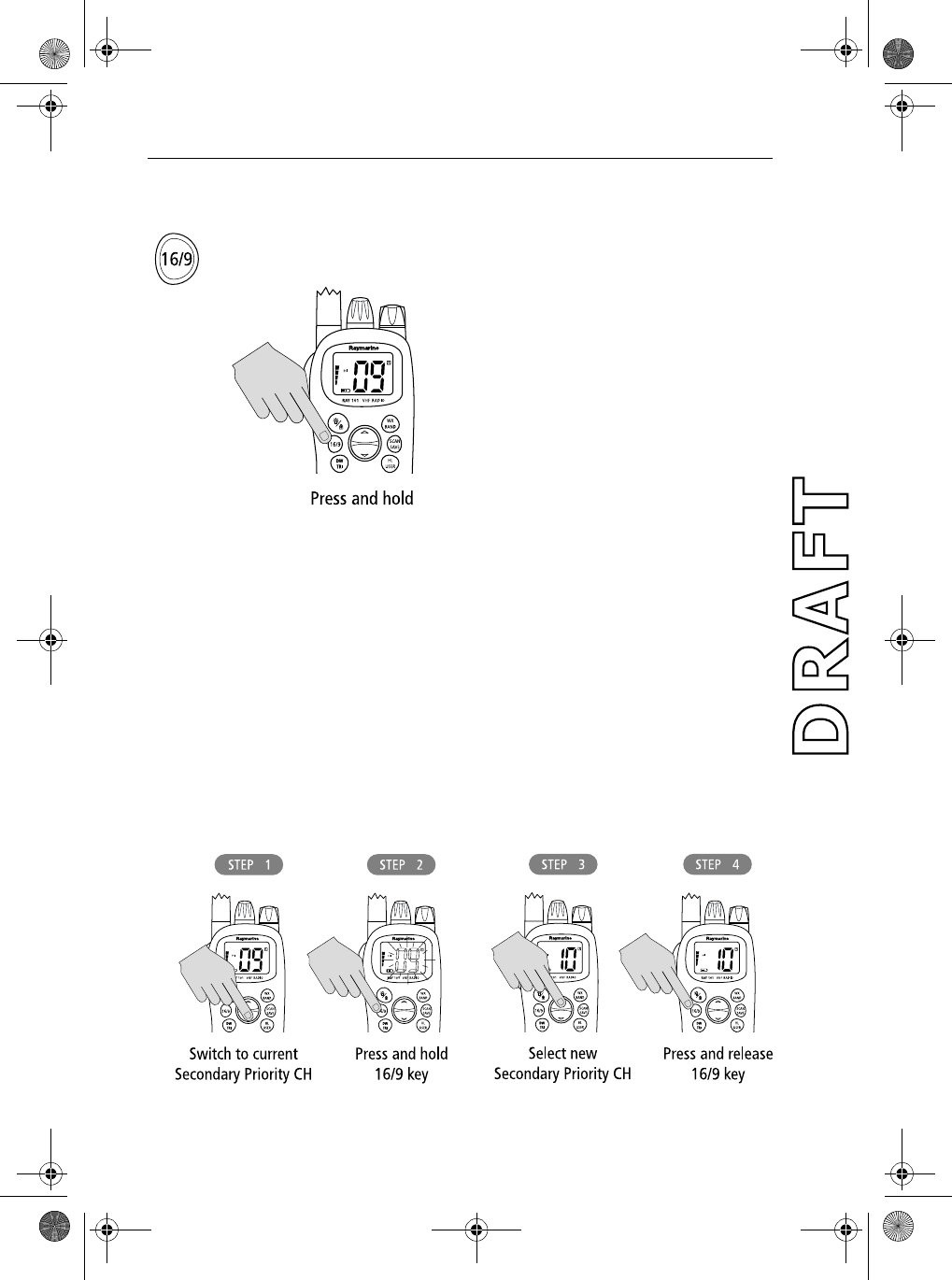
20 Ray101 Handheld VHF Radio
4.9 Selecting the Secondary Priority Channel
The Ray101E enables you to program the 16/9 key to store a Secondary
Priority Channel. The default is CH 9.
If on a working channel, press and hold the 16/
9 for greater than 3 seconds to switch to the
Secondary Priority Channel at high power. The
default is CH 9.
If on primary Priority CH16, press and hold the
16/9for greater 3 seconds to switch to the
Secondary Priority Channel at HI power. The
default is CH 9.If already on Secondary Priority
Channel, press and release the 16/9 key to
switch to Priority Channel 16 at high power.
Reprogramming the Secondary Priority Channel
1. Switch to the Secondary Priority Channel.
2. Press and hold the 16/9 key for greater 3 seconds to switch to Repro-
gram mode. An alert tone sounds and the current Secondary Priority
Channel flashes.
3. Change the channel number with the UP and DOWN arrow keys.
4. Press and release the 16/9 key to save the new Secondary Priority selec-
tion. An alert tone sounds to indicate that the Secondary Priority has been
changed.
During the reprogramming of the Secondary Priority Channel, the PTT,
DUAL/TRI, and WX/BAND keys are disabled and sound error beep if
pressed.
81229_1.book Page 20 Wednesday, November 12, 2003 2:39 PM
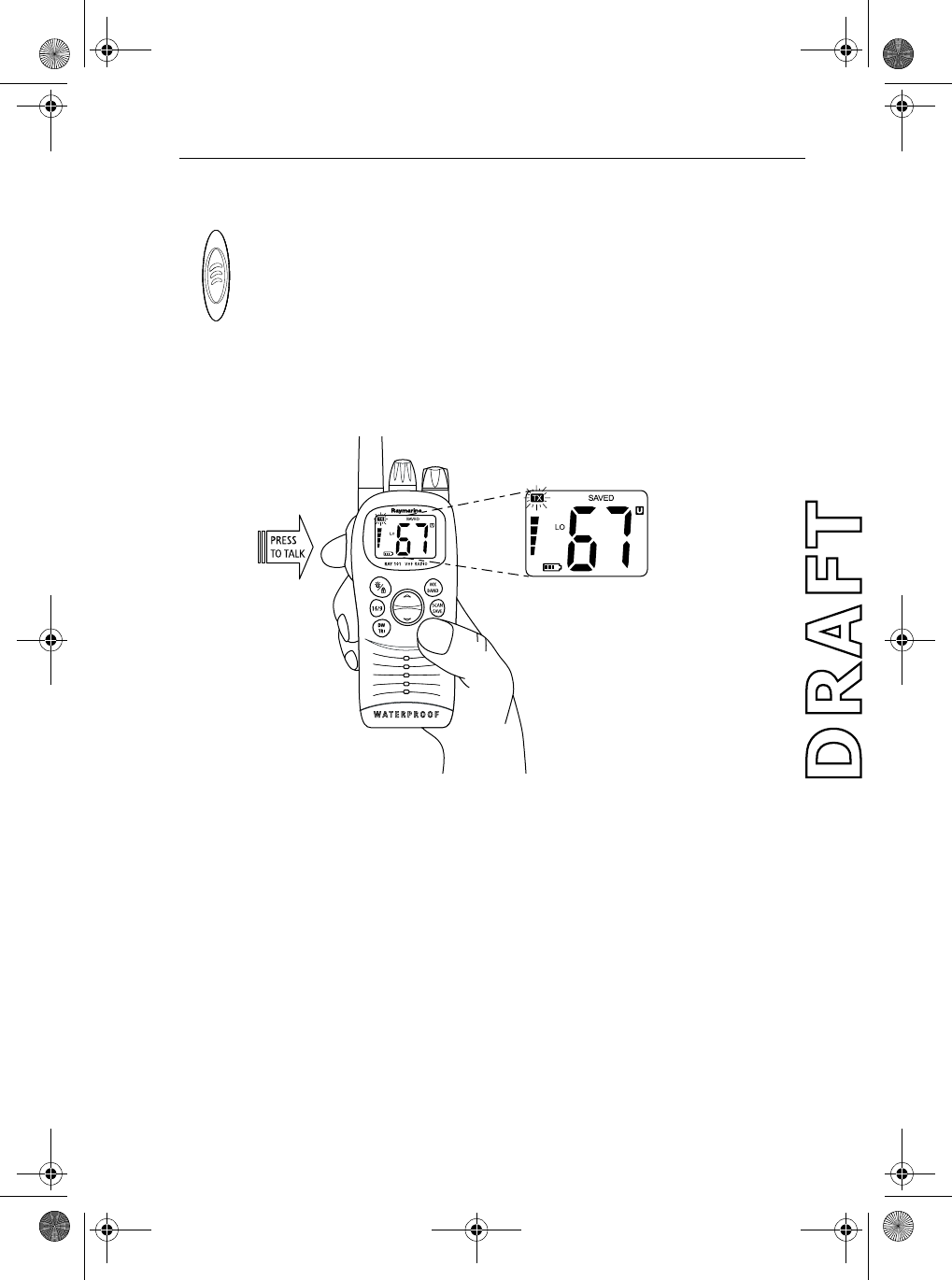
Chapter 4: Operations 21
4.10 Transmitting
Press and hold the Press-to-talk (PTT) key to transmit on the selected
channel, then release to receive. The TX indicator appears during
transmission.
The radio is equipped with a timeout timer in the event of a stuck key. After
PTT has been held continuously for 5 minutes, transmission is discontinued
and the radio automatically returns to receive mode. An Error beep is emitted
10 seconds before the time out is triggered and TX flashes on the display until
PTT is released.
The TX time out timer is reset once the PTT key is released.
Note: If the current channel is a TX-prohibited channel, an alarm sounds
when PTT is pressed, indicating such a transmission is not permitted.
81229_1.book Page 21 Wednesday, November 12, 2003 2:39 PM
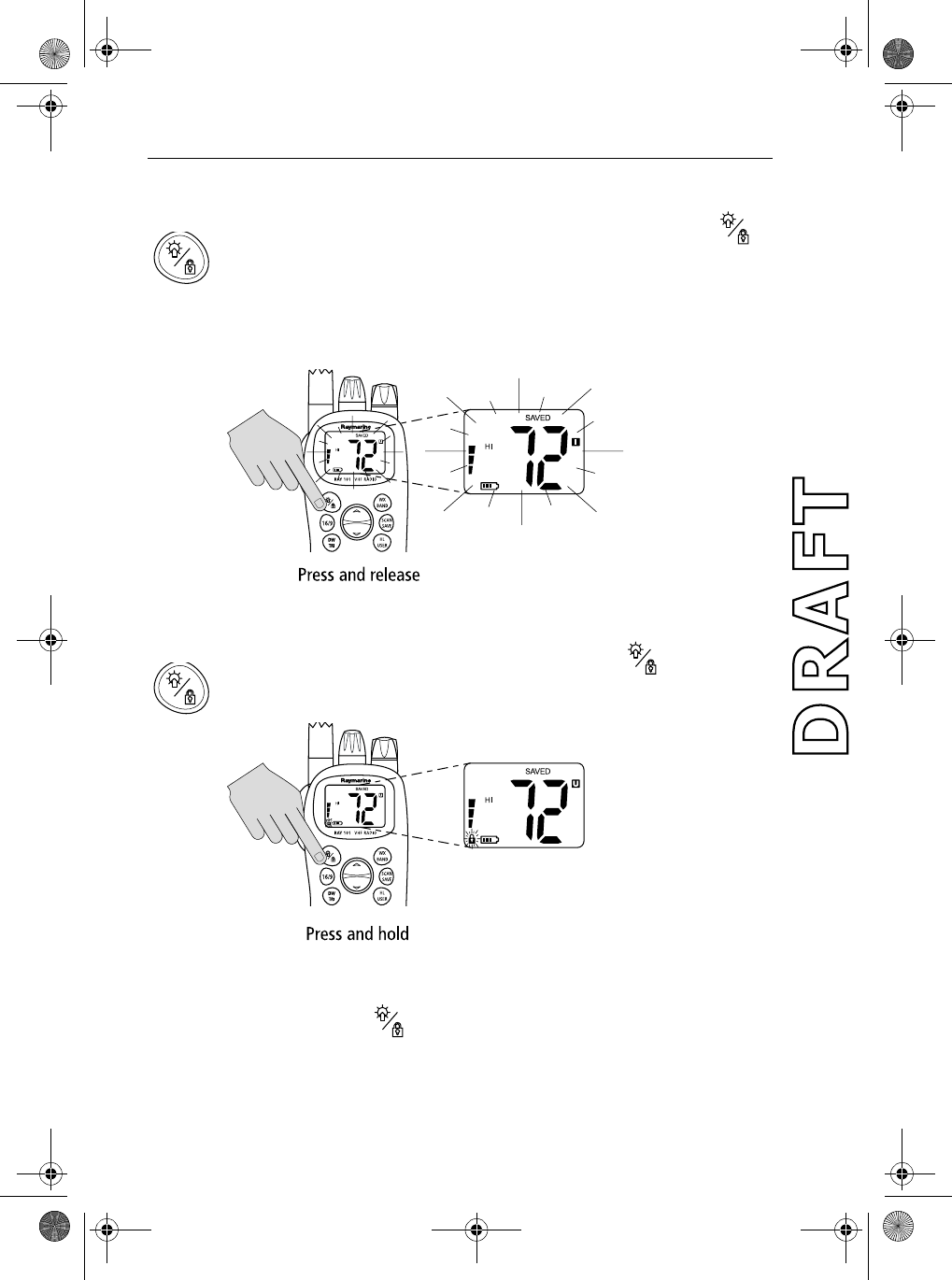
22 Ray101 Handheld VHF Radio
4.11 Turning On the Backlight
To toggle the display’s Backlight ON or OFF, press and release the
key.
When the Backlight setting is enabled, any key press except PTT turns on the
backlight for 5 seconds. If a key is pressed within the time frame, the time out
is reset. The default setting is ON.
4.12 Turning On the Keylock
To toggle the Keylock ON or OFF, press and hold the key for 3
seconds. When Keylock is enabled, the lock icon appears on the display.
The Keylock setting protects the radio from any keypad entry except for PTT
and the backlight function.
Press and hold the key again for 3 seconds to release the keylock.
81229_1.book Page 22 Wednesday, November 12, 2003 2:39 PM
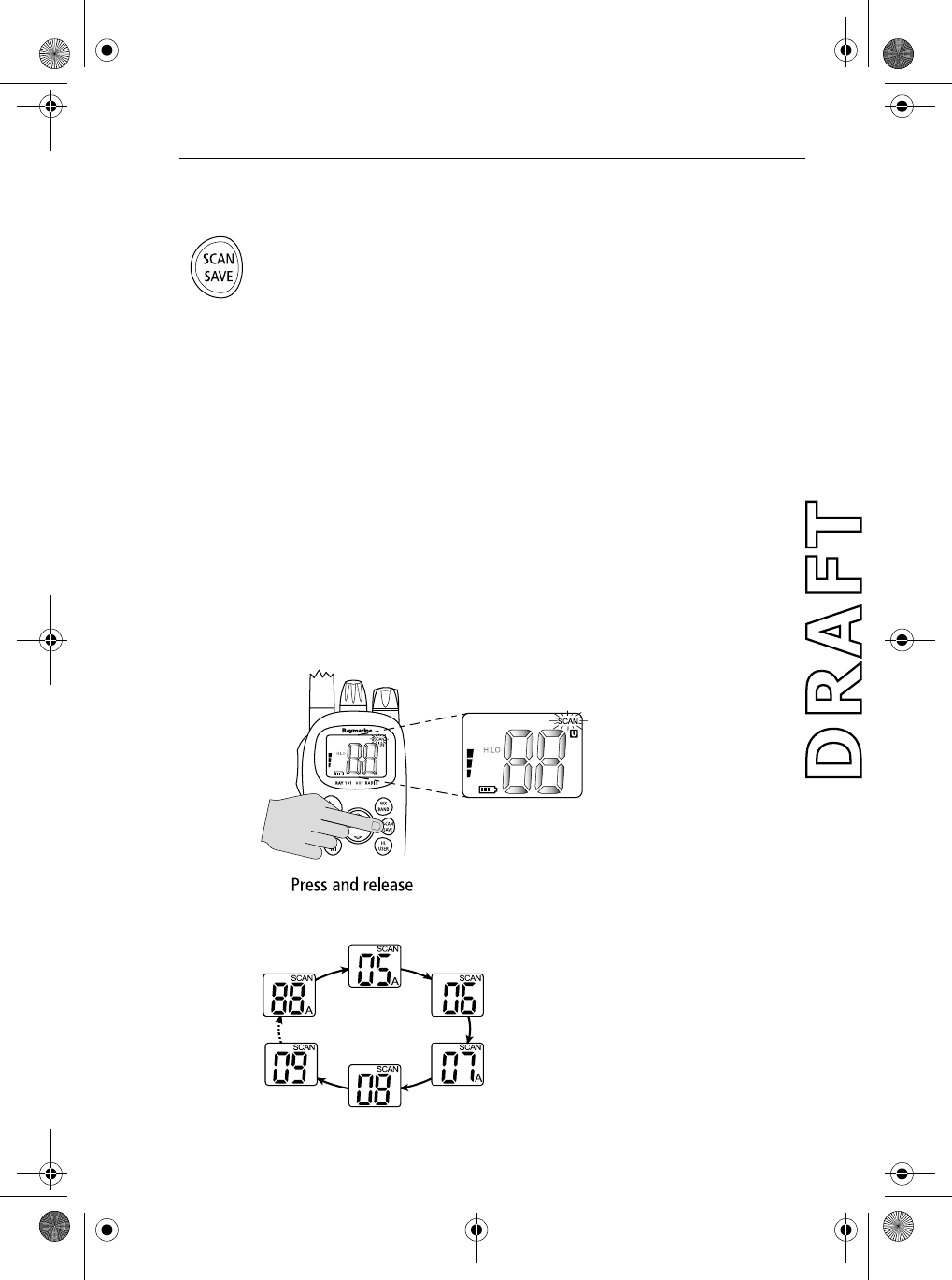
Chapter 4: Operations 23
4.13 Using the Scan Modes
The RAY101 is equipped with three types of scan options: All Scan, Saved
(Memory) Scan and Priority Scan. If there are no channels in memory, the
default is All Scan.
This function automatically searches for broadcasting channels. If a TX
signal is received, the scan stops on the receiving channel as long as it is
present. If the signal is lost for five seconds, the radio resumes scanning.
During the Scan Modes:
•Press the Channel UP/DOWN key to change the scan direction.
UP increments the channel while DOWN decrements it.
•Press and release SCAN/SAVE to terminate the SCAN mode and return to
the last-used channel
•DW/TRI and WX/BAND keys will not function and sounds an error
beep if pressed
All Scan
Press and release the SCAN/SAVE key when no channels are stored in
memory to activate the All Scan function.
The SCAN indicator appears on the LCD during All Scan.
In All Scan mode, all channels in the
channel set are scanned in sequence,
assuming no channels have been stored in
memory. After the last channel number has
been scanned, the cycle repeats.
All Scan is demonstrated in the figure to
the left.
81229_1.book Page 23 Wednesday, November 12, 2003 2:39 PM
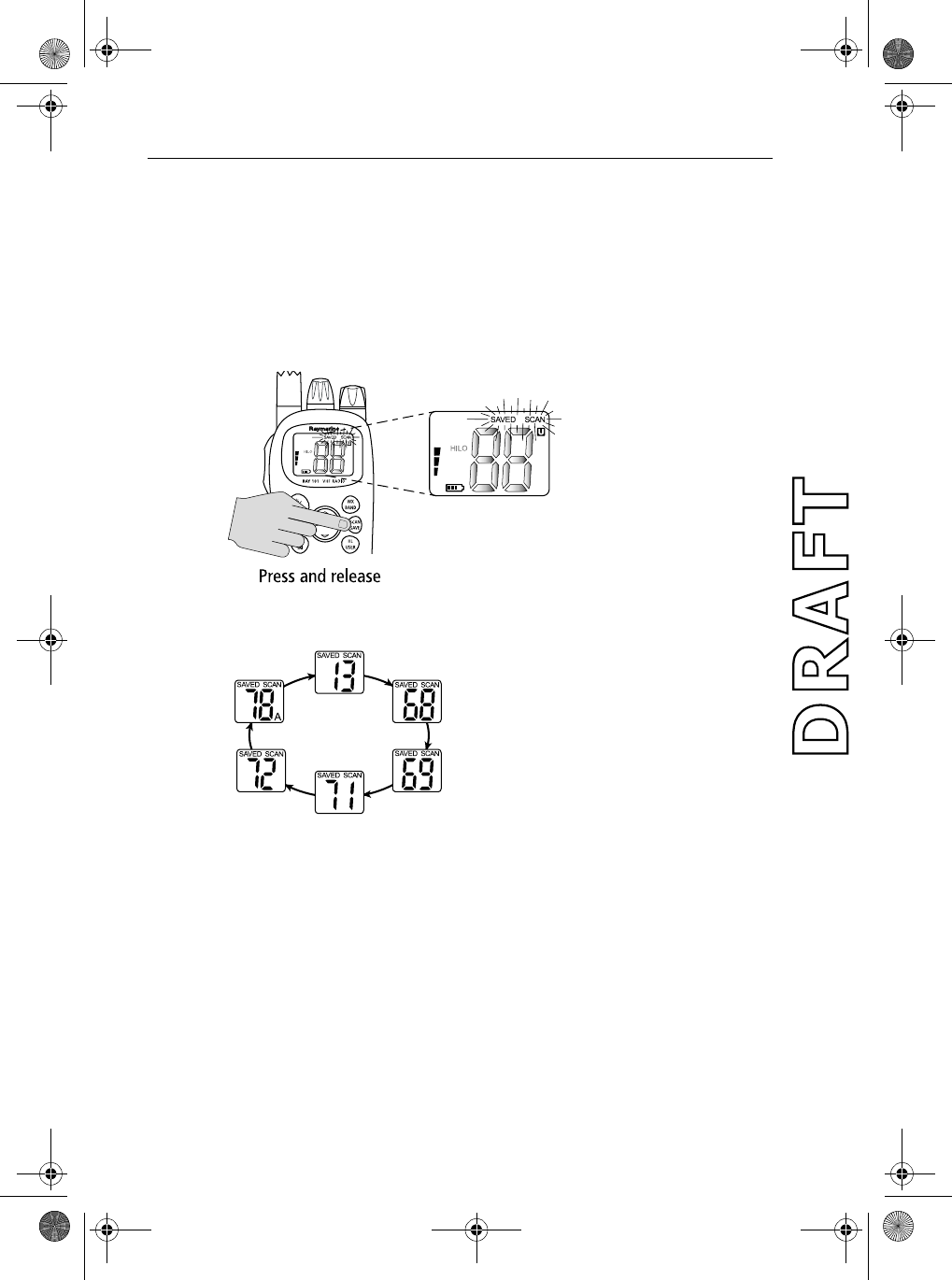
24 Ray101 Handheld VHF Radio
Note: Whenever Weather Alert is activated, the WX Alert channel is also
monitored during All Scan. If the WX Alert tone is detected, the scan is halted
to broadcast the Weather Alert message.
Saved (Memory) Scan
Press and release the SCAN/SAVE key when there is at least one channel in
memory to activate the Saved Scan function.
In Saved Scan Mode, the SAVED and SCAN indicators appear on the LCD.
In Saved Scan mode, only the channels that
have been saved in memory are scanned in
sequence. After the last saved channel
number has been scanned, the cycle repeats.
Saved Scan is demonstrated in the figure to
the left.
Note: Whenever Weather Alert is activated, the WX Alert channel is also
monitored during Saved Scan. If the WX Alert tone is detected, the scan is
halted to broadcast the Weather Alert message.
81229_1.book Page 24 Wednesday, November 12, 2003 2:39 PM
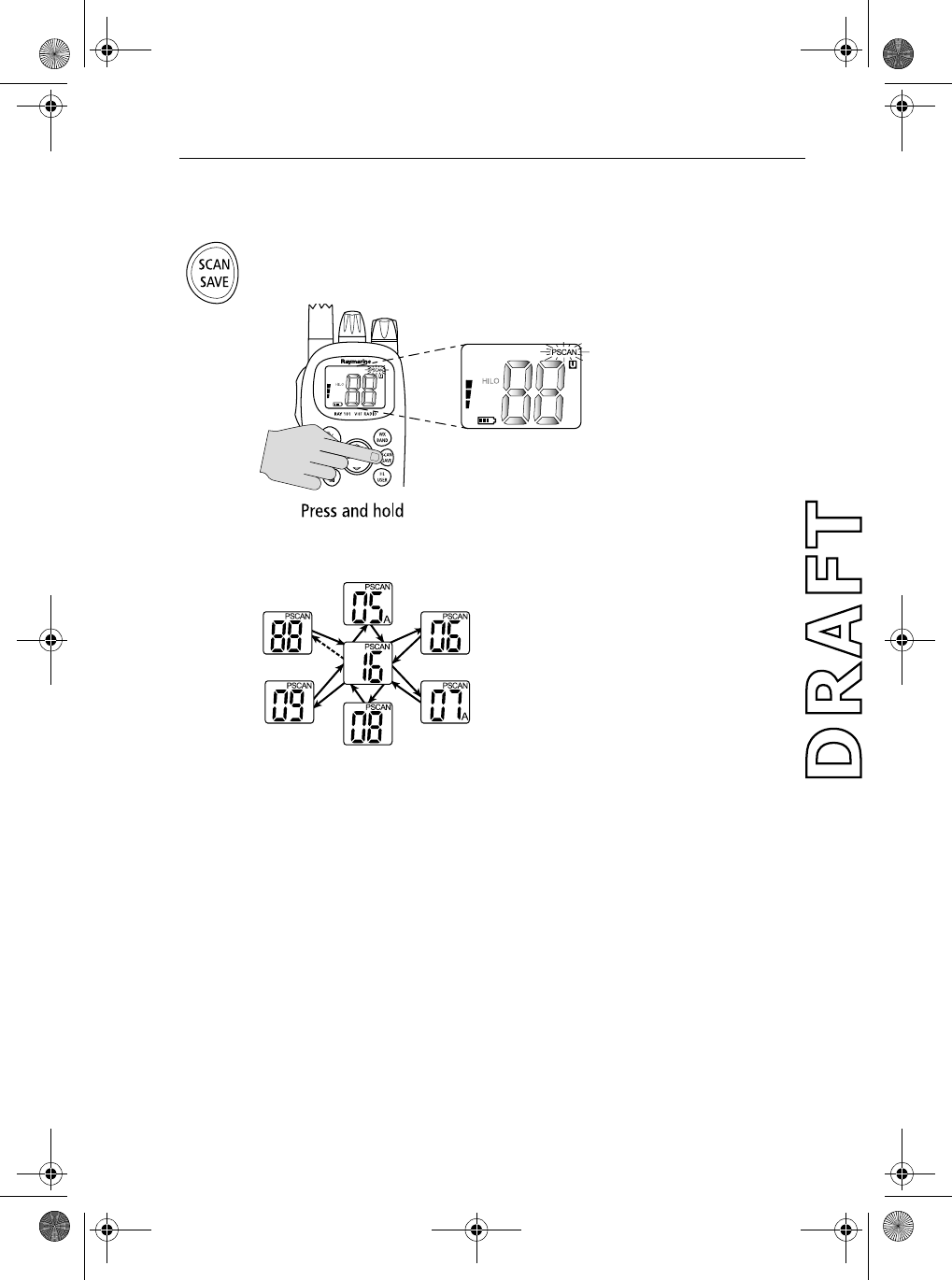
Chapter 4: Operations 25
Priority All Scan
Press and hold the SCAN/SAVE key while All Scan is active to initiate
Priority Scan.
.
During Priority Scan, the PSCAN indicator appears on the LCD.
Priority Scan searches for activity on all
channels but alternates scanning the
Priority Channel 16 after each channel.
Priority Scan is demonstrated in the
figure to the left.
Note: Whenever Weather Alert is activated, the WX Alert channel is also
monitored during Priority All Scan. If the WX Alert tone is detected, the
scan is halted to broadcast the Weather Alert message.
81229_1.book Page 25 Wednesday, November 12, 2003 2:39 PM
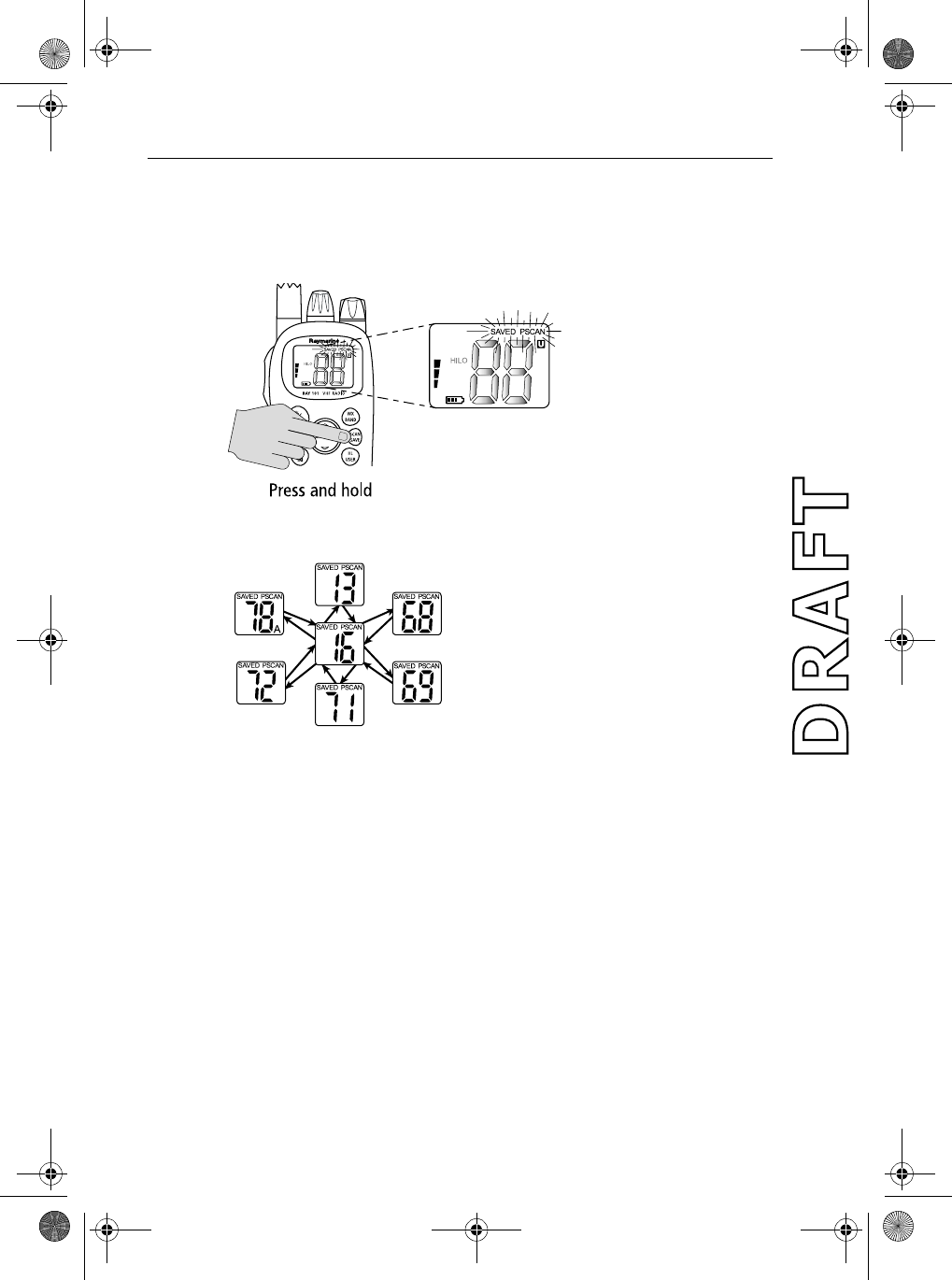
26 Ray101 Handheld VHF Radio
Priority Saved Scan
Press and hold the SCAN/SAVE key while Saved Scan is active to initiate
Priority Saved Scan.
The PSCAN and SAVED indicators appear on the LCD.
Priority Saved Scan is much like Priority
Scan except that the radio alternates
searching for activity on the Priority
Channel 16 and the channels stored in
memory.
Priority Saved Scan is demonstrated in the
figure to the left.
Note: Whenever Weather Alert is activated, the WX Alert channel is also
monitored during Priority Saved Scan. If the WX Alert tone is detected, the
scan is halted to broadcast the Weather Alert message.
Press and hold SCAN/SAVE for 3 seconds to exit Priority/Priority Saved
Scan and return to All/Memory Scan.
81229_1.book Page 26 Wednesday, November 12, 2003 2:39 PM
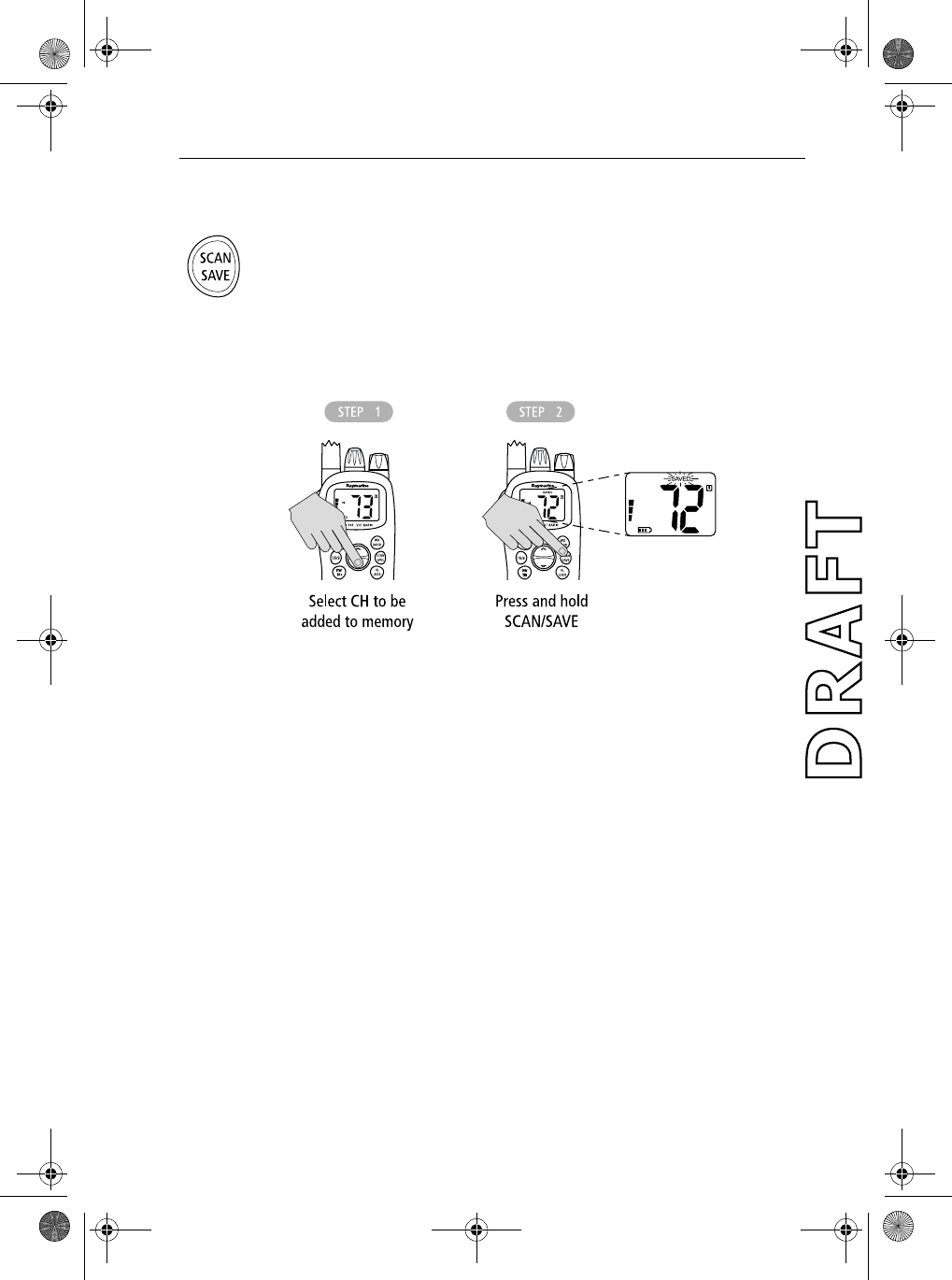
Chapter 4: Operations 27
4.14 Adding Channels to Memory
The Ray101 can store any channel. The stored channels are the ones scanned
in the Saved (Memory) Scan mode.
➤To Add Channels to Memory
1. During normal operation mode, use the UP/DOWN key to select the
desired channel for programming.
2. Press and hold the SCAN/SAVE key for 3 seconds.
The SAVED icon appears to indicate the current channel has been saved in
memory. Any number of channels can be saved as memory channels.
Separate memory channel groups exists for USA, International, and
Canadian frequency sets.
➤To Delete Channels from Memory
1. During the normal mode, use the UP/DOWN key to select the channel
to be deleted.
2. Press and hold the SCAN/SAVE key for 3 seconds.
The selected channel is deleted the channel from memory.
To view the channels set in memory, switch to USER mode, as described in
Section 4.16, USER Channel Mode.
81229_1.book Page 27 Wednesday, November 12, 2003 2:39 PM
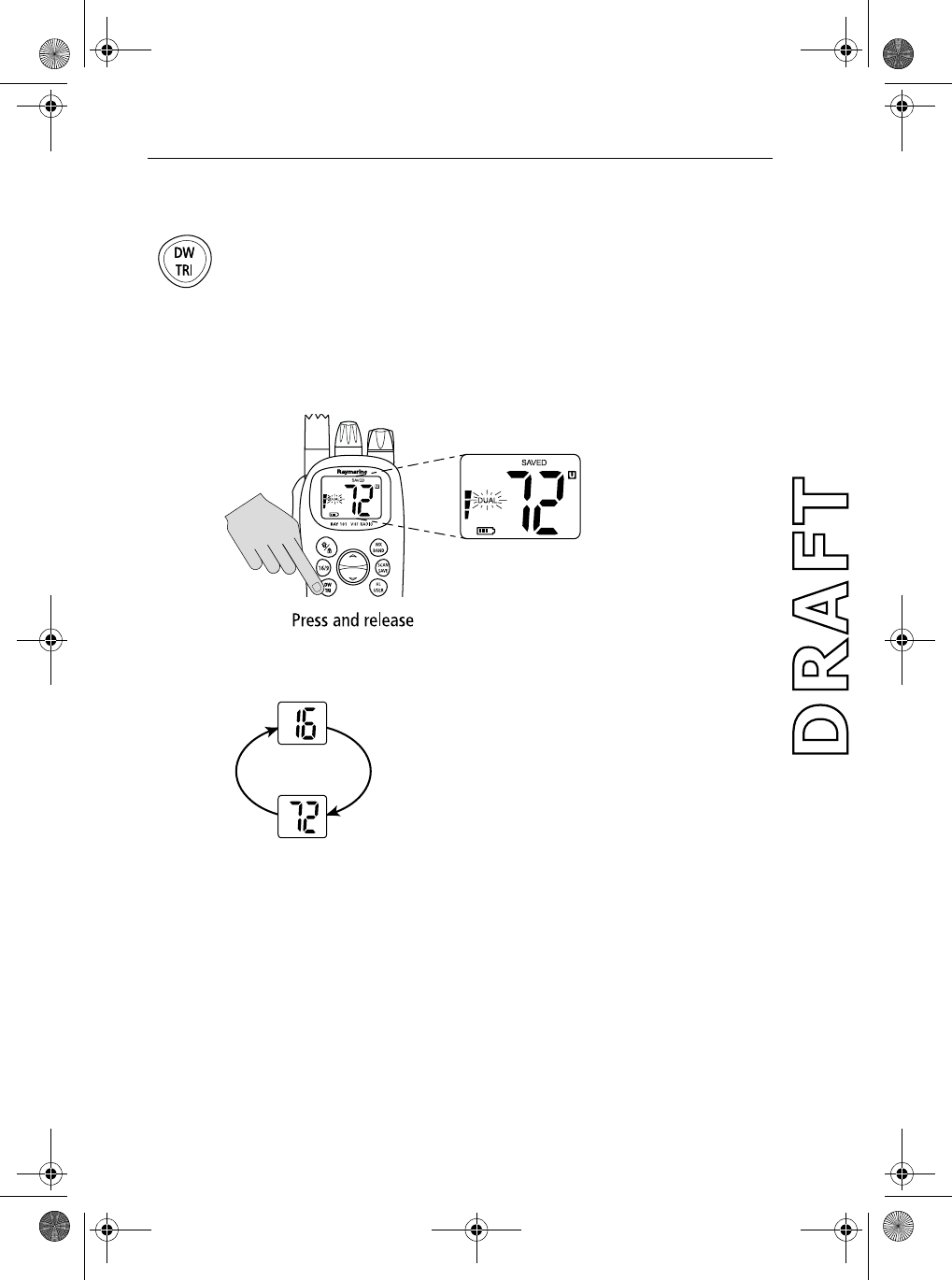
28 Ray101 Handheld VHF Radio
4.15 Using the Monitor Modes
The Watch Modes monitor the programmed Priority Channel and other user-
selected channel(s). The watch is halted when activity is detected on a
monitored channel. The Ray101 is equipped with 2 types of monitor
operations: Dual Watch and Tri Watch.
Dual Watch
Press and release the DW/TRI key to activate the Dual Watch mode.
The DUAL indicator appears on the LCD.
Dual Watch monitors the current working channel
and Channel 16 in cycle.
Dual Watch is demonstrated in the figure to the left;
the sample working channel is CH 72. Whenever
Weather Alert is activated, the WX Alert channel is
also monitored during Dual Watch.
Press and release the DW/TRI key to terminate Dual
Watch and return to the previous working channel.
Press and hold the DW/TRI key to terminate Dual Watch mode and go into
Tri Watch mode.
Press and release the 16/9 key to terminate Dual Watch mode and switch to
the Priority Channel.
Note: During Dual Watch mode, the SCAN/SAVE, USER, WX/BAND, and
Channel UP/DOWN keys are inactive and sounds an error beep if pressed.
81229_1.book Page 28 Wednesday, November 12, 2003 2:39 PM
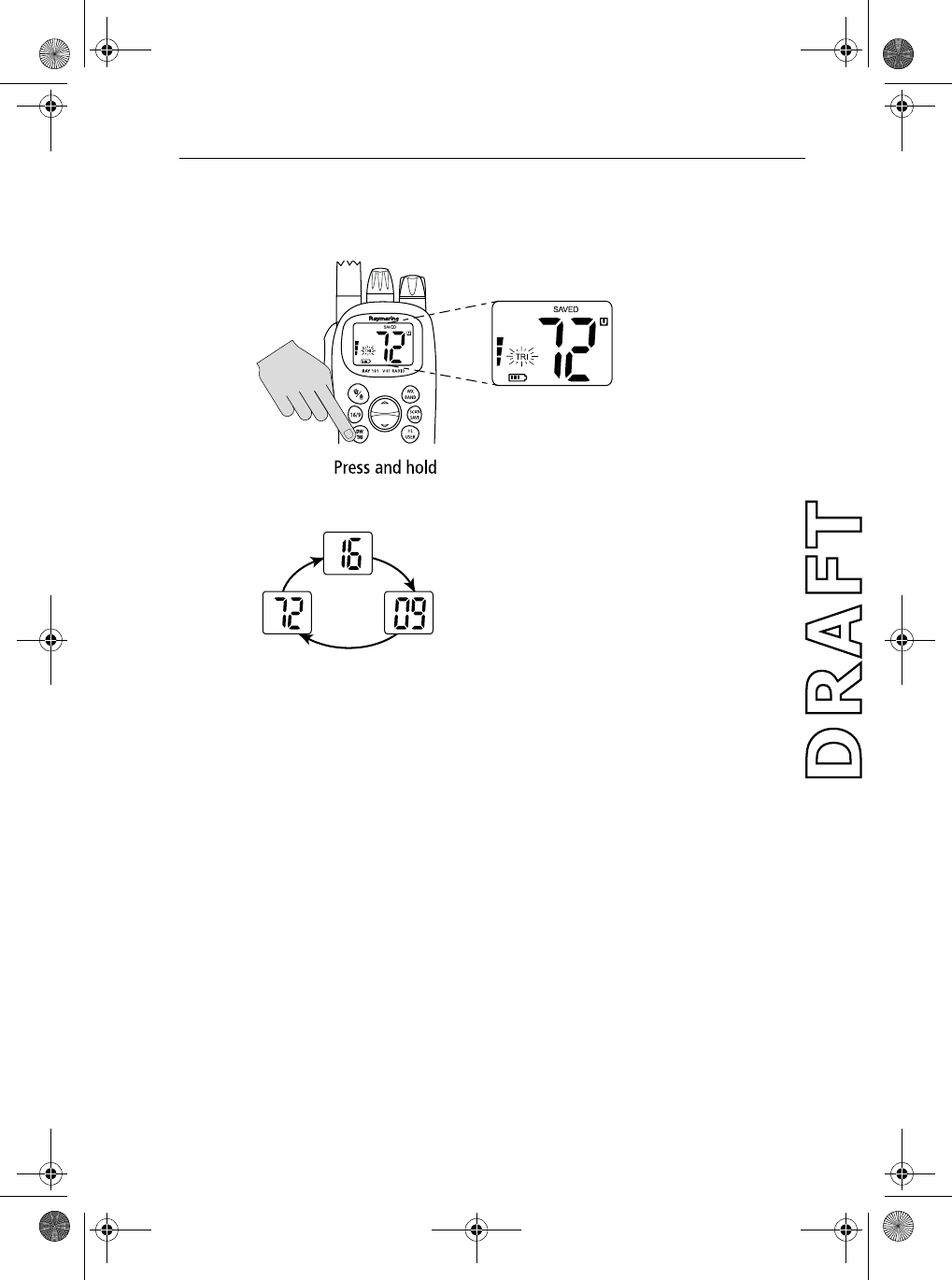
Chapter 4: Operations 29
Tri Watch
Press and hold the DW/TRI key for 3 seconds to activate Tri Watch mode.
The TRI indicator appears on the LCD.
Tri Watch monitors in cycle Channel 16, the
current working channel and the channel you
have set as the Secondary Priority Channel.
Tri Watch is demonstrated in the figure to the
left; the sample working channel is CH 72.
Note: Whenever Weather Alert is activated, the WX Alert channel is also
monitored during Tri Watch.
Press and release the DW/TRI key to terminate Tri Watch and return to the
previous working channel.
Press and release the 16/9 key to terminate Tri Watch mode and switch to
the Priority Channel.
Note: During Tri Watch Mode, the SCAN/SAVE, USER, WX/BAND, and
Channel UP/DOWN keys are inactive and sounds an error beep if pressed.
81229_1.book Page 29 Wednesday, November 12, 2003 2:39 PM
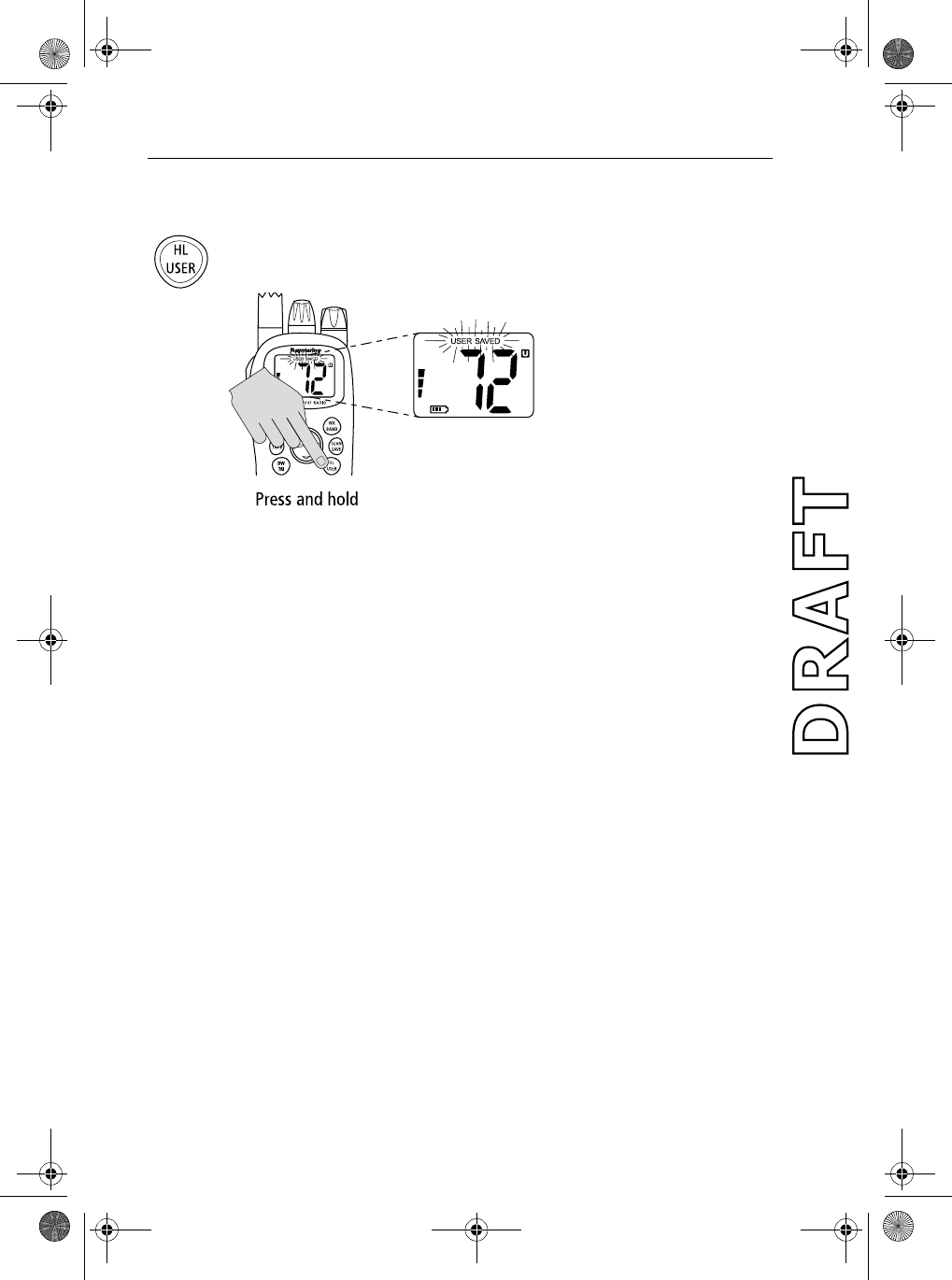
30 Ray101 Handheld VHF Radio
4.16 USER Channel Mode
Press and hold the HL/USER key while in normal operation mode to enter
User Mode. The USER and SAVED indicators appear.
USER Channel Mode displays only the channels that you have saved to
memory, which enables you to easily use your favorite channels while
bypassing unwanted or seldom-used channels during a scan.
Note: The procedure for saving a channel to memory is outlined in Section
4.14, Adding Channels to Memory.
While in User Mode:
•Press and release the SCAN/SAVE key to start Memory Scan mode.
•Press and hold the SCAN/SAVE key to delete the current channel from
memory list.
•Press 16/9 to terminate User mode and switch to the Priority Channel.
Note: You cannot switch Channel sets while in User Mode. The WX/BAND
key does not function and sounds an error beep if pressed.
Press and hold the HL/USER key for 3 seconds to quit User mode and return
to the last-used working channel.
81229_1.book Page 30 Wednesday, November 12, 2003 2:39 PM
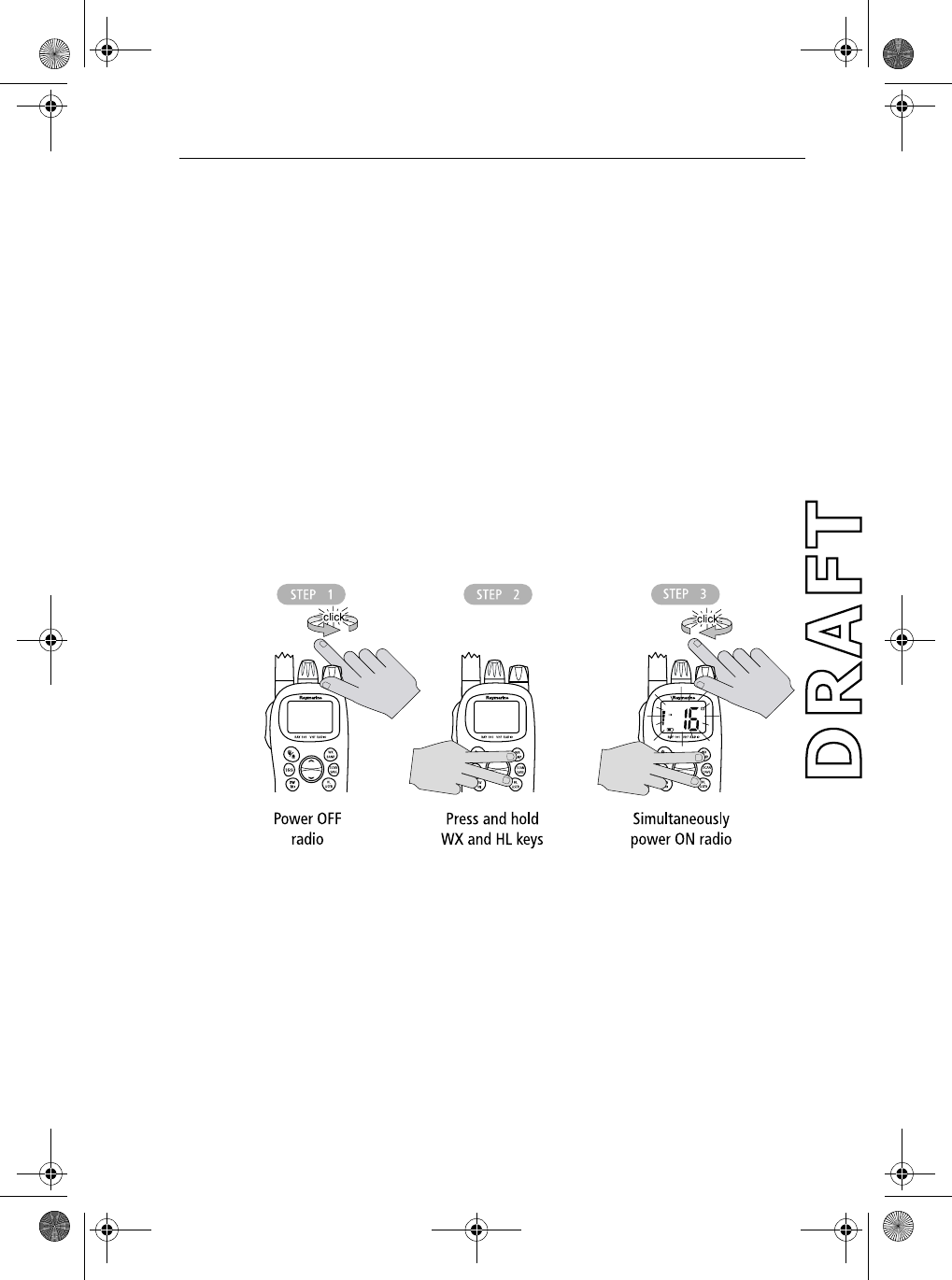
Chapter 4: Operations 31
4.17 Resetting Factory Defaults
You can reset many radio settings back to their factory defaults:
•Erase any channels stored in memory
•Turn OFF the backlight
•Return to US channels, if another mode is selected
•Turn OFF the Weather Alert setting, if active
•Return power settings to their original state
➤To perform the reset:
1. Turn the radio OFF.
2. Simultaneously press and hold the HL/USER and WX/BAND keys.
3. While continuing to hold these keys, power the radio ON.
The LCD remains blank for 2 seconds, and then the unit switches to
channel 16.
81229_1.book Page 31 Wednesday, November 12, 2003 2:39 PM

32 Ray101 Handheld VHF Radio
81229_1.book Page 32 Wednesday, November 12, 2003 2:39 PM

Appendix A: Specifications 33
Appendix A: Specifications
General
Receiver
Size (H x W x D) 5.55”(141mm) x 2.4” (61mm) x 1.69” (43mm) without
antenna
Weight 12.6 oz (357g)
Power Source 7.2V DC (6 x AA Alkaline or AA Ni-MH Batteries)
Environmental:
Operating Range:
Storage Range:
Humidity:
Waterproof to IPX7
-10°C to +55°C
-20°C to +70°C
up to 95% at 35°C non-condensing
Frequency Range:
Transmit
Receive 156.025 To 157.425 MHz
156.050 To 163.275 MHz
Channels All available US, Canadian and International VHF Marine
Band.
Oscillate Mode PLL
Modulation FM 16K0G3E
Channel Spacing 25 kHz Increments
Frequency Stability +/- 10PPM (+/- 0.001%)
Antenna Socket SMA
Display 38.4mm x 48.3mm LCD
Built in Speaker Ø36mm / Impedance 8 Ohm
Sensitivity (12dB SINAD) 0.30uV
Squelch Sensitivity (threshold) 0.20uV
Spurious Response Rejection Ratio >60 dB
Adjacent Channel Selectivity >60 dB
Intermodulation Rejection Ratio >60 dB
S/N at 3KHz Dev. >37 dB
Audio Output Power At THD 10% 400mW max
81229_1.book Page 33 Wednesday, November 12, 2003 2:39 PM

34 Ray101 Handheld VHF Radio
Transmitter
Audio Distortion <5%
Audio Response +1/-3dB from true 6dB de-empha-
sis from 300 to 2500 Hz, reference
1000Hz. Audio frequencies 3-20
KHz attenuated (at 1KHz by 60 log
f / 3 dB; above 20KHz by 50 dB)
Current Drain at: Max Audio Power
Standby
Power Saving
230mA
50mA
20mA
RF Power: Hi Mode
Lo Mode 5 W
1 W
Modulation FM 16K0G3E
Maximum Deviation ±5 KHz
Frequency Stability +/- 10 ppm (-20°C to +50°C)
S/N at 3KHz Dev. 34 dB
Modulation Distortion +/– 3KHz <5%
Audio Response +1/-3dB from true 6dB pre-
emphasis from 300 to 2500 Hz,
reference 1000Hz. Audio frequen-
cies 3-20 KHz attenuated (at 1KHz
by 60 log f / 3 dB; above 20KHz by
50 dB)
Spurious/Harmonic Emissions < 60 dB
Modulation Sensitivity 20mV
Current Drain Hi Power
Lo Power 1800mA
700mA
81229_1.book Page 34 Wednesday, November 12, 2003 2:39 PM

Appendix B: Channel List 35
Appendix B: Channel List
U.S. VHF Marine Radio Channels and Frequencies
CH.
No XMIT
Freq RCV
Freq Single
Freq Use
01A 156.050 156.050 x Port Operations and Commercial, VTS.
Available only in New Orleans / Lower Mississippi area.1
05A 156.250 156.250 x Port Operations or VTS in the Houston, New Orleans and Seattle
areas.
06 156.300 156.300 x Intership Safety
07A 156.350 156.350 x Commercial
08 156.400 156.400 x Commercial (Intership only)
09 156.450 156.450 x Boater Calling. Commercial and Non-Commercial.
10 156.500 156.500 x Commercial
11 156.550 156.550 x Commercial. VTS in selected areas.
12 156.600 156.600 x Port Operations. VTS in selected areas.
13 156.650 156.650 x Intership Navigation Safety (Bridge-to-bridge). Ships >20meters in
length maintain a listening watch on this channel in US waters.2
14 156.700 156.700 x Port Operations. VTS in selected areas.
15 - 156.750 x Environmental (Receive only). Used by Class ‘C’ EPIRBs.
16 156.800 156.800 x International Distress, Safety and Calling. Ships required to carry
radio, USCG, and most coast stations maintain a listening watch on
this channel.3
17 156.850 156.850 x State Control
18A 156.900 156.900 x Commercial
19A 156.950 156.950 x Commercial
20 157.000 161.600 Port Operations (duplex)
20A 157.000 157.000 x Port Operations
21A 157.050 157.050 x U.S. Coast Guard only
81229_1.book Page 35 Wednesday, November 12, 2003 2:39 PM

36 Ray101 Handheld VHF Radio
22A 157.100 157.100 x Coast Guard Liaison and Maritime Safety Information Broadcasts.
Broadcasts announced on channel 16.
23A 157.150 157.150 x U.S. Coast Guard only
24 157.200 161.800 Public Correspondence (Marine Operator)
25 157.250 161.850 Public Correspondence (Marine Operator)
26 157.300 161.900 Public Correspondence (Marine Operator)
27 157.350 161.950 Public Correspondence (Marine Operator)
28 157.400 162.000 Public Correspondence (Marine Operator)
63A 156.175 156.175 x Port Operations and Commercial, VTS. Available only in New
Orleans / Lower Mississippi area.
65A 156.275 156.275 x Port Operations
66A 156.325 156.325 x Port Operations
67 156.375 156.375 x Commercial. Used for Bridge-to-bridge communications in lower
Mississippi River. Intership only.
68 156.425 156.425 x Non-Commercial
69 156.475 156.475 x Non-Commercial
70 156.525 156.525 x Digital Selective Calling (voice communications not allowed)
71 156.575 156.575 x Non-Commercial
72 156.625 156.625 x Non-Commercial (Intership only)
73 156.675 156.675 x Port Operations
74 156.725 156.725 x Port Operations
77 156.875 156.875 x Port Operations (Intership only)
78A 156.925 156.925 x Non-Commercial
79A 156.975 156.975 x Commercial. Non-Commercial in Great Lakes only.
80A 157.025 157.025 x Commercial. Non-Commercial in Great Lakes only
81A 157.075 157.075 x U.S. Government only – Environmental protection operations.
82A 157.125 157.125 x U.S. Government only
CH.
No XMIT
Freq RCV
Freq Single
Freq Use
81229_1.book Page 36 Wednesday, November 12, 2003 2:39 PM
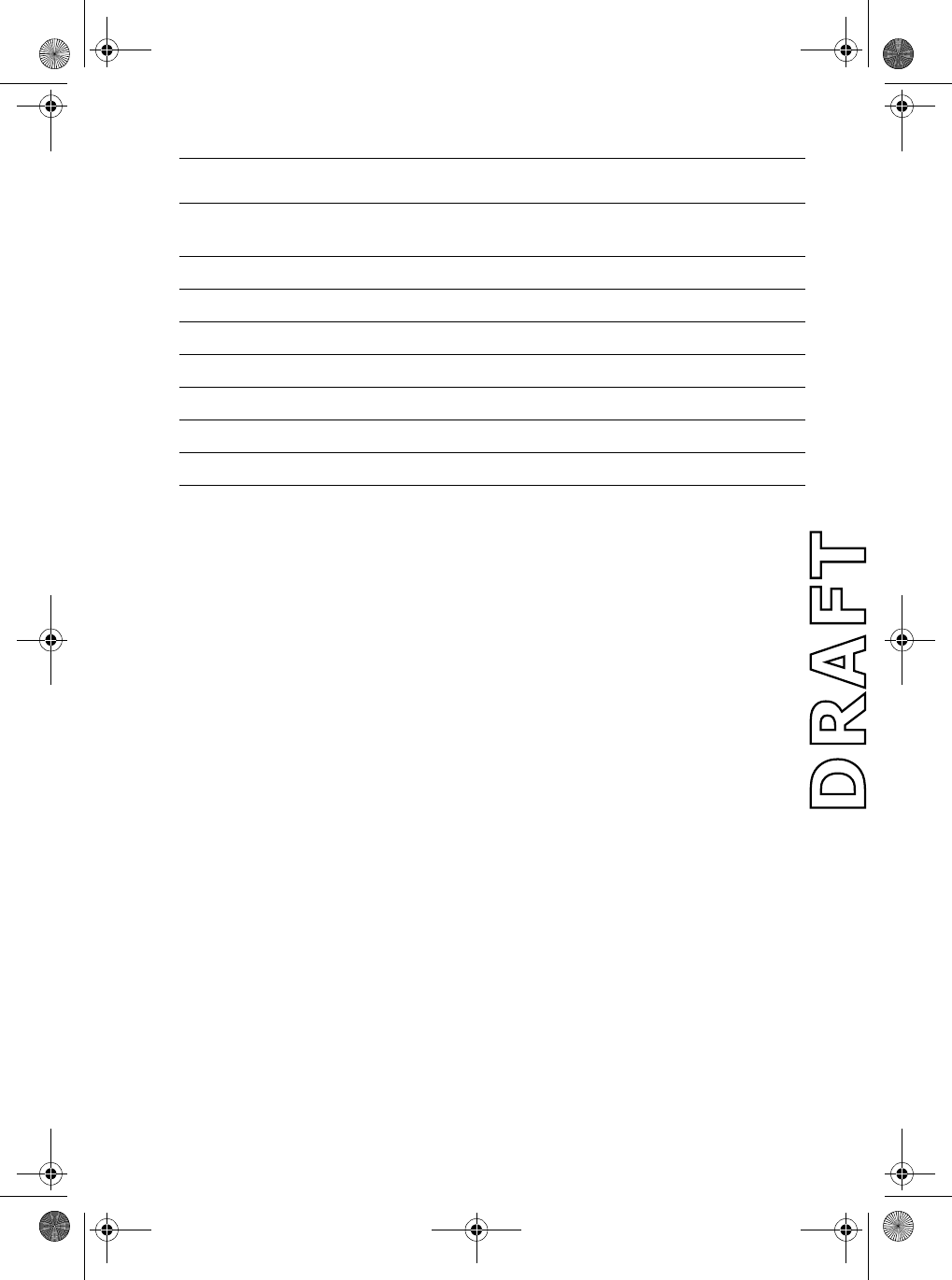
Appendix B: Channel List 37
Boaters should normally use channels listed as Non-Commercial.
Notes:
1. The letter “A” following a channel number indicates simplex use of the ship station
transmit side of an international duplex channel. Operations are different from that
of international operations on that channel.
2. Channel 13 should be used to contact a ship when there is danger of collision. All
ships of length 20 meters or greater are required to guard VHF channel 13, in addi-
tion to VHF channel 16, when operating within U.S. territorial waters.
3. Channel 16 is used for calling other stations or for distress alerting.
83A 157.175 157.175 x U.S. Coast Guard only
84 157.225 161.825 Public Correspondence (Marine Operator)
85 157.275 161.875 Public Correspondence (Marine Operator)
86 157.325 161.925 Public Correspondence (Marine Operator)
87 157.375 161.975 Public Correspondence Marine Operator)
88 157.425 162.025 Public Correspondence only near Canadian border
88A 157.425 157.425 x Commercial, Intership only
CH.
No XMIT
Freq RCV
Freq Single
Freq Use
81229_1.book Page 37 Wednesday, November 12, 2003 2:39 PM

38 Ray101 Handheld VHF Radio
Canadian VHF Marine Radio Channels and Frequencies
CH
No. XMIT
Freq RCV
Freq Area of
Operation Use
01 156.050 160.650 PC Public Correspondence
02 156.100 160.700 PC Public Correspondence
03 156.150 160.750 PC Public Correspondence
04A 156.200 156.200 PC Intership, Ship/Shore and Safety:
Canadian Coast Guard search and rescue1
04A 156.200 156.200 EC Intership, Ship/Shore and Commercial:
Commercial fishing only
05A 156.250 156.250 Ship Movement
06 156.300 156.300 All areas Intership, Commercial, Non-commercial and Safety:
May be used for search and rescue communications between
ships and aircraft.
07A 156.350 156.350 All areas Intership, Ship/Shore, Commercial
08 156.400 156.400 WC, EC Intership, Commercial and Safety:
Also assigned for operations in the Lake Winnipeg area.
09 156.450 156.450 AC Intership, Ship/Shore, Commercial, Non-commercial and Ship
Movement: May be used to communicate with aircraft and
helicopters in predominantly maritime support operations.
10 156.500 156.500 AC, GL Intership, Ship/Shore, Commercial, Non-commercial, Safety
and Ship Movement: May also be used for communications
with aircraft engaged in coordinated search and rescue and
antipollution operations.
11 156.550 156.550 PC, AC, GL Intership, Ship/Shore, Commercial, Non-commercial and Ship
Movement: Also used for pilotage purposes.
12 156.600 156.600 WC, AC, GL Intership, Ship/Shore, Commercial, Non-commercial and Ship
Movement: Port operations and pilot information and mes-
sages.
13 156.650 156.650 All areas Intership, Commercial, Non-commercial and Ship Movement:
Exclusively for bridge-to-bridge navigational traffic.
14 156.700 156.700 AC, GL Intership, Ship/Shore, Commercial, Non-commercial and Ship
Movement: Port operations and pilot information and mes-
sages.
81229_1.book Page 38 Wednesday, November 12, 2003 2:39 PM

Appendix B: Channel List 39
15 156.750 156.750 All areas Intership, Ship/Shore, Commercial, Non-commercial and Ship
Movement: All operations limited to 1-watt maximum power.
May also be used for on-board communications.
16 156.800 156.800 All areas International Distress, Safety and Calling2
17 156.850 156.850 All areas Intership, Ship/Shore, Commercial, Non-commercial and Ship
Movement: All operations limited to 1-watt maximum power.
May also be used for on-board communications.
18A 156.900 156.900 All areas Intership, Ship/Shore and Commercial:
Towing on the Pacific Coast.
19A 156.950 156.950 All areas
except PC Intership and Ship/Shore:
Canadian Coast Guard only.
19A 156.950 156.950 PC Intership and Ship/Shore:
Various Government departments.
20 157.000 161.600 All areas Ship/Shore, Safety and Ship Movement:
Port operations only with 1-watt maximum power.
21A 157.050 157.050 All areas Intership and Ship/Shore:
Canadian Coast Guard only.
21B - 161.650 All areas Safety: Continuous Marine Broadcast (CMB) service.3
22A 157.100 157.100 All areas Intership, Ship/Shore, Commercial and Non-commercial:
For communications between Canadian Coast Guard and non-
Canadian Coast Guard stations only.
23 157.150 161.750 PC Ship/Shore and Public Correspondence:
Also in the inland waters of British Columbia and the Yukon.
24 157.200 161.800 All areas Ship/Shore and Public Correspondence
25 157.250 161.850 PC Ship/Shore and Public Correspondence: Also assigned for
operations in the Lake Winnipeg area.
25B - 161.850 AC Safety: Continuous Marine Broadcast (CMB) service.
26 157.300 161.900 All areas Ship/Shore, Safety and Public Correspondence
27 157.350 161.950 AC, GL, PC Ship/Shore and Public Correspondence
28 157.400 162.000 PC Ship/Shore, Safety and Public Correspondence
28B - 162.000 AC Safety: Continuous Marine Broadcast (CMB) service.
CH
No. XMIT
Freq RCV
Freq Area of
Operation Use
81229_1.book Page 39 Wednesday, November 12, 2003 2:39 PM

40 Ray101 Handheld VHF Radio
60 156.025 160.625 PC Ship/Shore and Public Correspondence
61A 156.075 156.075 PC Intership and Ship/Shore:
Canadian Coast Guard only.
61A 156.075 156.075 EC Intership, Ship/Shore and Commercial:
Commercial fishing only.
62A 156.125 156.125 PC Intership and Ship/Shore:
Canadian Coast Guard only.
62A 156.125 156.125 EC Intership, Ship/Shore and Commercial:
Commercial fishing only.
64 156.225 160.825 PC Ship/Shore and Public Correspondence
64A 156.225 156.225 EC Intership, Ship/Shore and Commercial:
Commercial fishing only.
65A 156.275 156.275 Intership, Ship/Shore, Commercial, Non-commercial, Safety:
Search & rescue and antipollution operations on the Great
Lakes. Towing on the Pacific Coast. Port operations only in the
St. Lawrence River areas with 1W maximum power. Pleasure
craft in the inland waters of Alberta, Saskatchewan and Mani-
toba (excluding Lake Winnipeg and the Red River).
66A 156.325 156.325 Intership, Ship/Shore, Commercial, Non-commercial, Safety
and Ship Movement: Port operations only in the St.Lawrence
River/Great Lakes Areas with 1-watt maximum power.
67 156.375 156.375 EC Intership, Ship/Shore and Commercial:
Commercial fishing only.
67 156.375 156.375 All areas
except EC Intership, Ship/Shore, Commercial, Non-commercial, Safety:
May also be used for communications with aircraft engaged in
coordinated search and rescue and antipollution operations.
68 156.425 156.425 All areas Intership, Ship/Shore and Non-commercial:
For marinas and yacht clubs.
69 156.475 156.475 All areas
except EC Intership, Ship/Shore, Commercial and Non-commercial
69 156.475 156.475 EC Intership, Ship/Shore and Commercial:
Commercial fishing only.
70 156.525 156.525 All areas Digital Selective Calling for Distress, Safety and Calling
CH
No. XMIT
Freq RCV
Freq Area of
Operation Use
81229_1.book Page 40 Wednesday, November 12, 2003 2:39 PM

Appendix B: Channel List 41
71 156.575 156.575 PC Intership, Ship/Shore, Commercial, Non-commercial, Safety
and Ship Movement
71 156.575 156.575 Intership, Ship/Shore and Non-commercial: For marinas and
yacht clubs on the East Coast and on Lake Winnipeg.
72 156.625 156.625 EC, PC Intership, Commercial and Non-commercial:
May be used to communicate with aircraft and helicopters in
predominantly maritime support operations.
73 156.675 156.675 EC Intership, Ship/Shore and Commercial:
Commercial fishing only
73 156.675 156.675 All areas
except EC Intership, Ship/Shore, Commercial, Non-commercial, Safety:
May also be used for communications with aircraft engaged in
coordinated search and rescue and antipollution operations.
74 156.725 156.725 EC, PC Intership, Ship/Shore, Commercial, Non-commercial and Ship
Movement
75 - - All areas Not available – Guard band for Channel 16
76 - - All areas Not available – Guard band for Channel 16
77 156.875 156.875 Intership, Ship/Shore, Safety and Ship Movement:
Pilotage on Pacific Coast. Port operations only in the St.
Lawrence River/Great Lakes areas with 1W maximum power.
78A 156.925 156.925 EC, PC Intership, Ship/Shore and Commercial
79A 156.975 156.975 EC, PC Intership, Ship/Shore and Commercial
80A 157.025 157.025 EC, PC Intership, Ship/Shore and Commercial
81A 157.075 157.075 Intership and Ship/Shore: Canadian Coast Guard use only in
the St. Lawrence River/Great Lakes areas.
81A 157.075 157.075 PC Intership, Ship/Shore and Safety:
Canadian Coast Guard antipollution.
82A 157.125 157.125 PC Intership, Ship/Shore and Safety:
Canadian Coast Guard use only.
82A 157.125 157.125 Intership and Ship/Shore: Canadian Coast Guard use only in
the St. Lawrence River/Great Lakes areas.
83 157.175 161.775 PC Ship/Shore and Safety:
Canadian Coast Guard use only.
CH
No. XMIT
Freq RCV
Freq Area of
Operation Use
81229_1.book Page 41 Wednesday, November 12, 2003 2:39 PM

42 Ray101 Handheld VHF Radio
Area of Operation
AC: Atlantic Coast, Gulf and St. Lawrence River up to and including Montreal
EC (East Coast): includes NL, AC, GL and Eastern Arctic areas
GL: Great Lakes (including St. Lawrence above Montreal)
NL: Newfoundland and Labrador
PC: Pacific Coast
WC (West Coast): Pacific Coast, Western Arctic and Athabasca-Mackenzie Watershed areas
All areas: includes East and West Coast areas
Notes:
1. The letter “A” following a channel number indicates simplex use of the ship sta-
tion transmit side of an international duplex channel. Operations are different from
that of international operations on that channel.
2. Channel 16 is used for calling other stations or for distress alerting.
3. The letter “B” following a channel number indicates simplex use of the coast station
transmit side of an international duplex channel. That is, the channel is Receive
Only.
83A 157.175 157.175 EC Intership and Ship/Shore:
Canadian Coast Guard and other Government agencies.
83B - 161.775 AC, GL Safety: Continuous Marine Broadcast (CMB) Service.
84 157.225 161.825 PC Ship/Shore and Public Correspondence
85 157.275 161.875 AC, GL, NL Ship/Shore and Public Correspondence
86 157.325 161.925 PC Ship/Shore and Public Correspondence
87 157.375 161.975 AC, GL, NL Ship/Shore and Public Correspondence
88 157.425 162.025 AC, GL, NL Ship/Shore and Public Correspondence
CH
No. XMIT
Freq RCV
Freq Area of
Operation Use
81229_1.book Page 42 Wednesday, November 12, 2003 2:39 PM

Appendix B: Channel List 43
International VHF Marine Radio Channels & Frequencies
CH
No. XMIT
Freq RCV
Freq Single
Freq Use
01 156.050 160.650 Public Correspondence, Port Operations and Ship Movement
02 156.100 160.700 Public Correspondence, Port Operations and Ship Movement
03 156.150 160.750 Public Correspondence, Port Operations and Ship Movement
04 156.200 160.800 Public Correspondence, Port Operations and Ship Movement
05 156.250 160.850 Public Correspondence, Port Operations and Ship Movement
06 156.300 156.300 x Intership 1
07 156.350 160.950 Public Correspondence, Port Operations and Ship Movement
08 156.400 156.400 x Intership
09 156.450 156.450 x Intership, Port Operations and Ship Movement
10 156.500 156.500 x Intership, Port Operations and Ship Movement 2
11 156.550 156.550 x Port Operations and Ship Movement
12 156.600 156.600 x Port Operations and Ship Movement
13 156.650 156.650 x Intership Safety, Port Operations and Ship Movement 3
14 156.700 156.700 x Port Operations and Ship Movement
15 156.750 156.750 x Intership and On-board Communications at 1W only 4
16 156.800 156.800 x Distress, Safety and Calling
17 156.850 156.850 x Intership and On-board Communications at 1W only 4
18 156.900 161.500 Public Correspondence
19 156.950 161.550 Public Correspondence, Port Operations and Ship Movement
20 157.000 161.600 Public Correspondence, Port Operations and Ship Movement
21 157.050 161.650 Public Correspondence, Port Operations and Ship Movement
22 157.100 161.700 Public Correspondence, Port Operations and Ship Movement
23 157.150 161.750 Public Correspondence, Port Operations and Ship Movement
24 157.200 161.800 Public Correspondence, Port Operations and Ship Movement
81229_1.book Page 43 Wednesday, November 12, 2003 2:39 PM

44 Ray101 Handheld VHF Radio
25 157.250 161.850 Public Correspondence, Port Operations and Ship Movement
26 157.300 161.900 Public Correspondence, Port Operations and Ship Movement
27 157.350 161.950 Public Correspondence, Port Operations and Ship Movement
28 157.400 162.000 Public Correspondence, Port Operations and Ship Movement
60 156.025 160.625 Public Correspondence, Port Operations and Ship Movement
61 156.075 160.675 Public Correspondence, Port Operations and Ship Movement
62 156.125 160.725 Public Correspondence, Port Operations and Ship Movement
63 156.175 160.775 Public Correspondence, Port Operations and Ship Movement
64 156.225 160.825 Public Correspondence, Port Operations and Ship Movement
65 156.275 160.875 Public Correspondence, Port Operations and Ship Movement
66 156.325 160.925 Public Correspondence, Port Operations and Ship Movement
67 156.375 156.375 x Intership, Port Operations and Ship Movement
68 156.425 156.425 x Port Operations and Ship Movement
69 156.475 156.475 x Port Operations and Ship Movement
70 156.525 156.525 x Digital Selective Calling for Distress, Safety and Calling 5
71 156.575 156.575 x Port Operations and Ship Movement
72 156.625 156.625 x Intership
73 156.675 156.675 x Intership 2
74 156.725 156.725 x Port operations and Ship movement
75 156.775 156.775 x See Note 6
76 156.825 156.825 x See Note 6
77 156.875 156.875 x Intership
78 156.925 161.525 Public correspondence, Port Operations and Ship Movement
79 156.975 161.575 Public correspondence, Port Operations and Ship Movement
80 157.025 161.625 Public correspondence, Port Operations and Ship Movement
81 157.075 161.675 Public correspondence, Port Operations and Ship Movement
CH
No. XMIT
Freq RCV
Freq Single
Freq Use
81229_1.book Page 44 Wednesday, November 12, 2003 2:39 PM
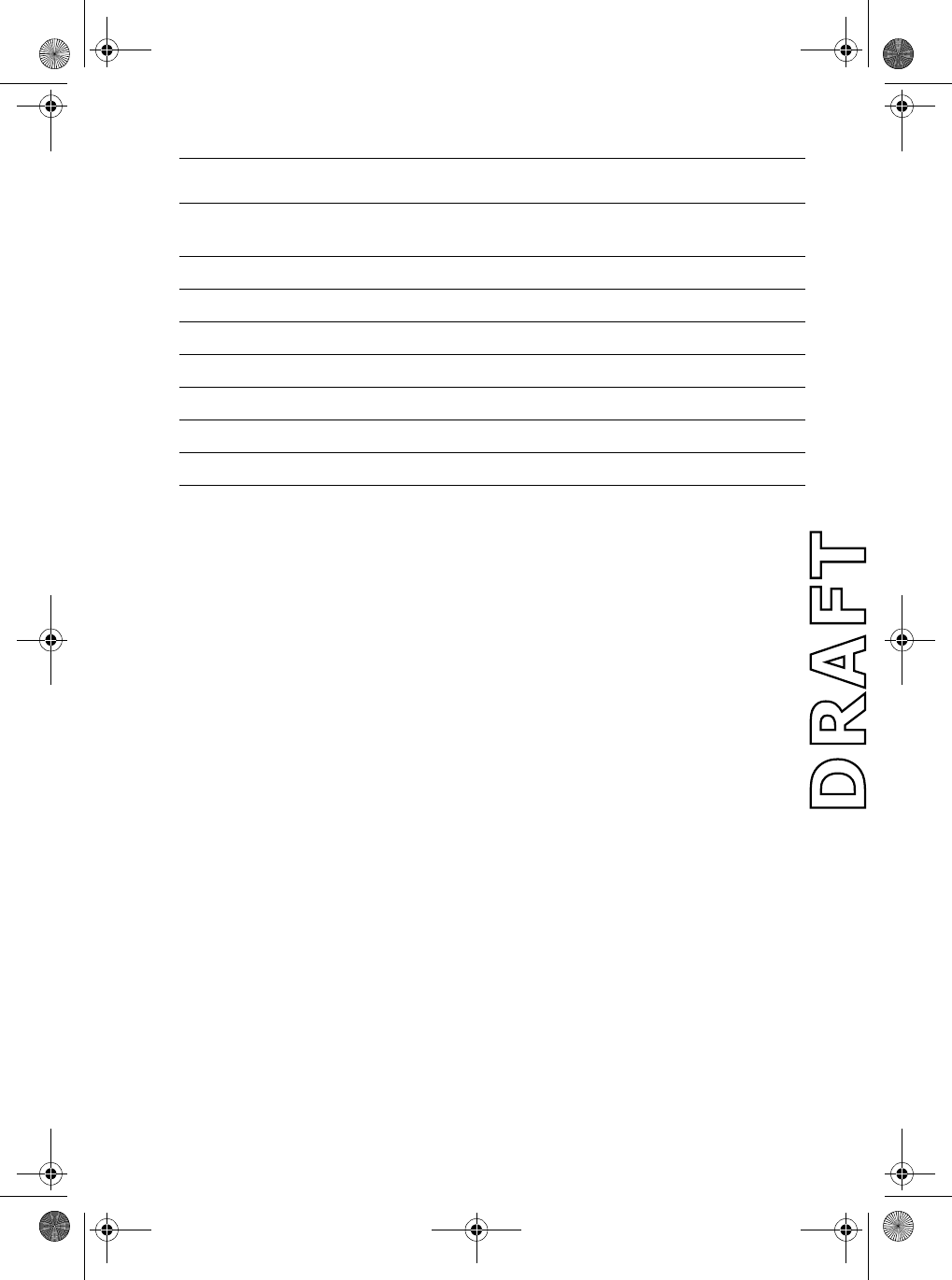
Appendix B: Channel List 45
Intership channels are for communications between ship stations.
Intership communications should be restricted to Channels 6, 8, 72 and 77.
If these are not available, the other channels marked for Intership may be used.
Channels 10, 67 and 73 should be avoided within VHF range of coastal areas in Europe
and Canada.
Notes:
1. Channel 06 may also be used for communications between ship stations and air-
craft engaged in coordinated search and rescue operations. Ship stations should
avoid harmful interference to such communications on channel 06 as well as to
communications between aircraft stations, ice breakers and assisted ships during
ice seasons.
2. Channels 10 or 73 (depending on location) are also used for the broadcast of
Marine Safety Information by the Maritime and Coast Guard Agency in the UK
only.
3. Channel 13 is designated for use on a worldwide basis as a navigation safety com-
munication channel, primarily for intership navigation safety communications.
4. Channels 15 and 17 may also be used for on-board communications provided the
effective radiated power does not exceed 1 Watt.
5. Channel 70 is to be used exclusively for digital selective calling for distress, safety
and calling.
6. The use of Channels 75 and 76 should be restricted to navigation related communi-
cation only and all precautions should be taken to avoid harmful interference to
channel 16, e.g., by limiting power to 1 Watt or by means of geographical location.
82 157.125 161.725 x Public correspondence, Port Operations and Ship Movement
83 157.175 161.775 x Public correspondence, Port Operations and Ship Movement
84 157.225 161.825 x Public correspondence, Port Operations and Ship Movement
85 157.275 161.875 x Public correspondence, Port Operations and Ship Movement
86 157.325 161.925 x Public correspondence, Port Operations and Ship Movement
87 157.375 157.375 Port Operations and Ship Movement
88 157.425 157.425 Port Operations and Ship Movement
CH
No. XMIT
Freq RCV
Freq Single
Freq Use
81229_1.book Page 45 Wednesday, November 12, 2003 2:39 PM

46 Ray101 Handheld VHF Radio
Weather Channel (WX) Frequencies
Weather
Channel Frequency
in MHz
WX 0 163.275
WX 1 162.550
WX 2 162.400
WX 3 162.475
WX 4 162.425
WX 5 162.450
WX 6 162.500
WX 7 162.525
WX 8 161.650
WX 9 161.775
81229_1.book Page 46 Wednesday, November 12, 2003 2:39 PM
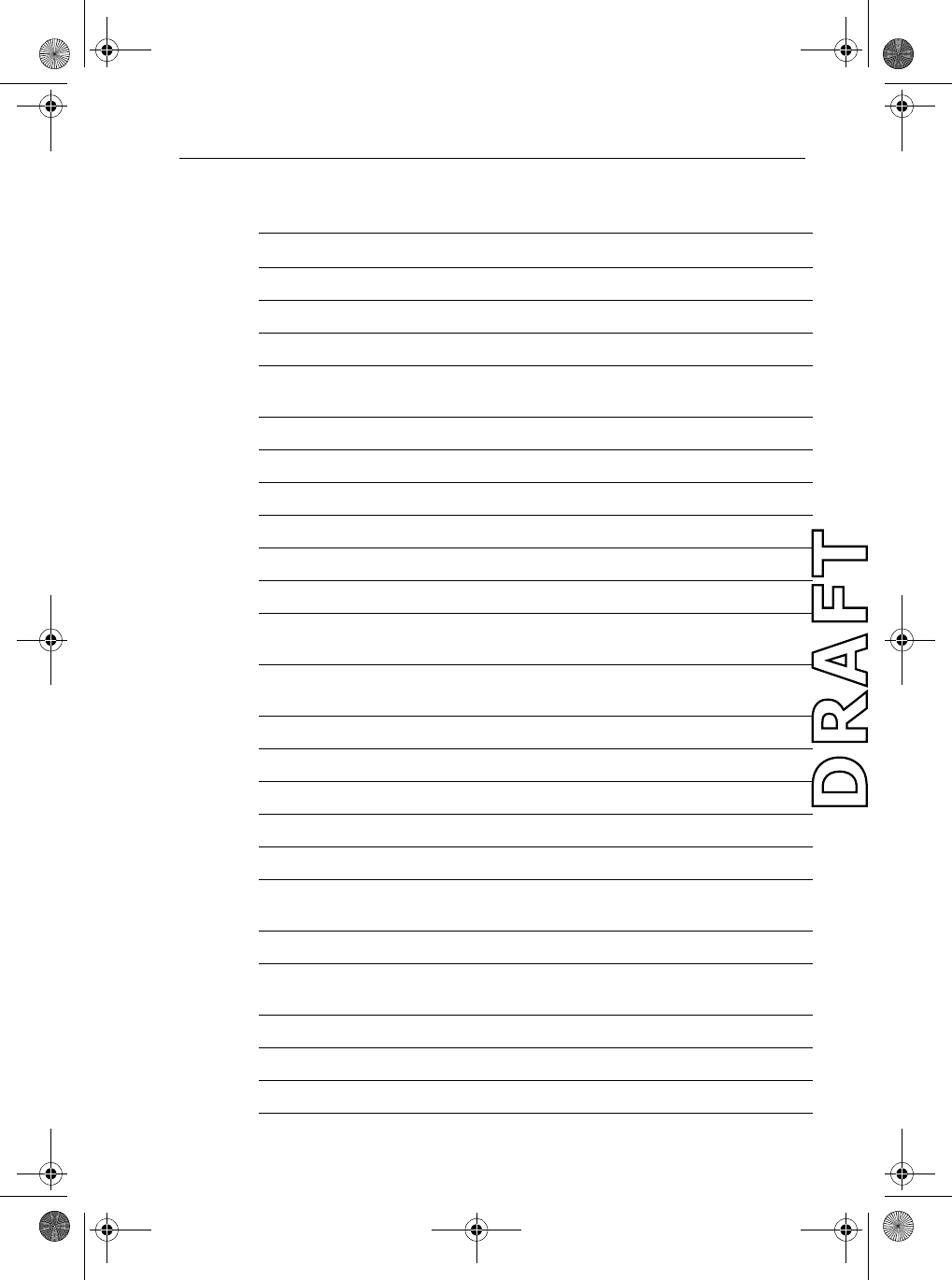
Appendix C: Glossary 47
Appendix C: Glossary
Term Meaning
All Scan A feature that scans all channels.
Canadian Channels Channel designator as defined by Industry Canada.
CH Channel selection key
Dual Watch A feature that monitors the Priority Channel 16 while working on
another channel.
Duplex Transmit and receive on different frequencies
FCC Federal Communications Commission (US)
International Channels Channel designator as defined by the ITU
ITU International Telecommunications Union
LCD Liquid Crystal Display
NOAA National Oceanographic and Atmospheric Administration (USA)
Priority Channel Channel 16 or 9 (or other secondary channel you have pro-
grammed)
Priority Scan (PSCAN) A feature that alternates monitoring the Priority Channel 16 with
each of the regular channels
PTT switch Microphone push-to-talk switch
RF Radio Frequency
RX Receive
Saved Scan Scans only user-selected memory channels
Simplex Transmit and receive on the same frequency
Squelch A circuit that sets the threshold for cutting off the receiver when the
signal is too weak for reception of anything but noise.
TX Transmit
Tri Watch A function that monitors the Priority Channel and Secondary Prior-
ity Channel while working on another channel.
US Channels Channel designations as defined by the FCC.
VOL Volume key
VHF Very High Frequency (30MHz to 300MHz)
81229_1.book Page 47 Wednesday, November 12, 2003 2:39 PM

48 Ray101 Handheld VHF Radio
Weather (WX) Channels Channels for routine and emergency weather information
broadcast by NOAA (USA).
WX Weather Band key
Working Channel The currently-selected (non-priority, non-WX) channel.
Term Meaning
81229_1.book Page 48 Wednesday, November 12, 2003 2:39 PM

49
Index
Symbols
"A" indicator 13
"B" indicator 13
"C" indicator 13
"I" indicator 13
"U" indicator 13
Numerics
16/9 key 11
A
Adding channels to memory 27
ALERT indicator 14
All Scan function 23
Antenna 5
B
Backlight 11, 22
BAND function 19
Battery 6
Charging 8
Level indicator 13
Tray 6
Type switch 7
Belt Clip 6
C
Canadian channels 38
Canadian licensing 3
CH indicator 13
Channel List
Canadian frequencies 38
International frequencies 43
US frequencies 35
WX frequencies 46
Channel Sets 19
Channel setting 17
Channel UP/DOWN 11
Charging batteries 8
Conventions iii
D
Delete channels from memory 27
DUAL indicator 14
Dual Watch 11, 28
E
Equipment suppied 5
F
Features 1
Frequency Band 19
Frequency settings
Canadian channels 38
International channels 43
US channels 35
WX channels 46
G
Glossary 47
H
HI/LO indicator 14
HI/LOW power selection 11, 16
HL/USER key 11
I
Installation 5
International channels 43
K
Keylock 11, 22
Keylock indicator 13
Keypad 9
L
LCD display 12
Licensing requirements 2
M
Memory 27
Monitor modes 28, 29
P
Power 10
Power ON/OFF 15
Power selection 16
Press-to-talk key 21
Priority Channel 19
Priority Scan function 25
PSCAN indicator 13
PTT 10, 21
81229_1.book Page 49 Wednesday, November 12, 2003 2:39 PM

50 Ray101 Handheld VHF Radio
R
Recharging batteries 8
RX indicator 12
S
Save channels to memory 27
SAVED indicator 13
Saved Scan function 24
Scan function 23
SCAN indicator 13
SCAN/SAVE key 11
Signal strength 14
Squelch 10, 16
T
Transmitting 21
TRI indicator 14
Tri Watch 11, 29
TX 21
TX indicator 12
U
US channels 35
USER Channel Mode 11, 30
USER indicator 12
V
Volume 15
W
Warning iv
Warranty iii
Weather Channels 17
Wrist Strap 6
WX 17
channels 46
indicator 14
WX/BAND key 11
81229_1.book Page 50 Wednesday, November 12, 2003 2:39 PM

Warranty Certificate - VHF/Communications Products
In order to ensure that the equipment continues to operate efficiently and reliably, we recom-
mend that before using the product, the customer carefully read the Owner’s Handbook and fol-
low the advice on the safe and correct operation and use of the product. We recommend that
Raymarine equipment be installed by an approved Raymarine installer.
1. Limited Product Warranty
Raymarine warrants that all of its products, in the course of normal use, will be free from defects
in material and workmanship for a period of 3 years (36 months) from date of sale to the original
owner, subject to the limitations set forth in this warranty.
Hailer horns, external speakers and accessories are warranted for 1 year (12 months) from date
of sale.
The Raymarine warranty covers the parts and labor associated with any warranty repair as
described above, provided that the product is returned to Raymarine or one of its approved
National distributors, in accordance with part 3 hereof.
2. Warranty Registration
Register your warranty on line at: http://www.raymarine.com.
3. Obtaining Warranty Service
In the event of warranty service being required, contact Raymarine or its approved national dis-
tributor – a full list of National distributors is available on Raymarine’s web site www.rayma-
rine.com or directly from Raymarine.
The affected product must be returned to Raymarine, or its approved national distributor with a
copy of:
(a) Proof of purchase showing the date of purchase and the name of the seller of the product;
and the serial number of the affected product; or
(b) A warranty card completed by the seller containing the information required in part (a)
above.
Subject to the limitations and other provisions set forth in this warranty, the product will be
either repaired or replaced by Raymarine within a reasonable period of time and at no further
cost to the customer. The determination of whether to repair or replace a product shall be at the
sole discretion of Raymarine and shall be the sole remedy of the customer under this warranty.
Warranty Limitations
Raymarine warranty does not apply to equipment that has been subjected to accident, abuse or
misuse, shipping damage, alterations, corrosion, incorrect and/or non-authorized service, or
product on which the serial number has been altered, mutilated or removed.
Raymarine assumes no responsibility for damage incurred during installation or as a result of
improper installation.
This warranty does not cover routine system checkouts, alignment/calibration, sea-trials or com-
missioning, unless required by replacement of part(s) in the area being aligned.
Raymarine is not liable and assumes no responsibility for damage caused by or to other equip-
ment, systems or components occasioned by improper or unauthorized connection, or use, of the
product.
81229_1.book Page 1 Wednesday, November 12, 2003 2:39 PM

Document number: 84162-1
September 2003
Consumable items, including, but not limited to: fuses, batteries and lamps are specifically
excluded from this warranty and Raymarine has no liability for such items.
Travel costs, overtime/premium labor portion of services outside of normal working hours is
not covered by this warranty.
If repairs are necessary under the warranty, the affected product must be forwarded to a Ray-
marine facility or an approved Raymarine service agent, at owner’s expense in a manner set
forth in part 3 hereof.
This warranty does not cover any differences in material, coloring, or size between those
alluded to in corporate advertising, literature or published on the Internet, which is not specif-
ically objected to at the time of delivery.
To the extent consistent with State and Federal law:
1. The foregoing warranty is Raymarine’s sole warranty and is applicable only to
products sold as new. The remedies provided herein are in lieu of (i) any and all other
remedies and warranties, whether express or implied including but not limited to, any
implied warranty of merchantability or fitness for a particular purpose; and (ii) all
obligations of Raymarine for damages including, but not limited to accidental,
consequential or special damages (including punitive or multiple), or any financial
loss, loss of profit, business, contracts, opportunity, goodwill or other similar loss
arising out of or in connection with the purchase, use or performance of any
Raymarine product, even if Raymarine has been advised of the possibility of such
damages, and no case shall exceed the cost of the product. The remedies to the
customer herein are exclusive.
2. Raymarine does not warranty products purchased via discount auctions or
web-sites.*
Some jurisdictions do not allow exclusion or limitation of incidental or consequen-
tial damages so the above limitations or exclusions may not apply to you. This war-
ranty gives you specific legal rights and you may also have other rights, which vary
from jurisdiction to jurisdiction.
Raymarine, Inc. is the sole authors of this policy and makes no other warranties,
express or implied unless a separate, specific warranty has been written and pro-
vided to the customer. This warranty supersedes and replaces all previous warran-
ties.
The Raymarine warranty terms and conditions herein do not effect the customer’s
statutory rights and comply with EU Directive 1999/44/EC.
* May not be applicable in EU
All Raymarine products are sold or provided hereunder are merely aids to navigation.
It is the responsibility of the user to exercise discretion and proper navigational skill
independent of any Raymarine equipment.
81229_1.book Page 2 Wednesday, November 12, 2003 2:39 PM
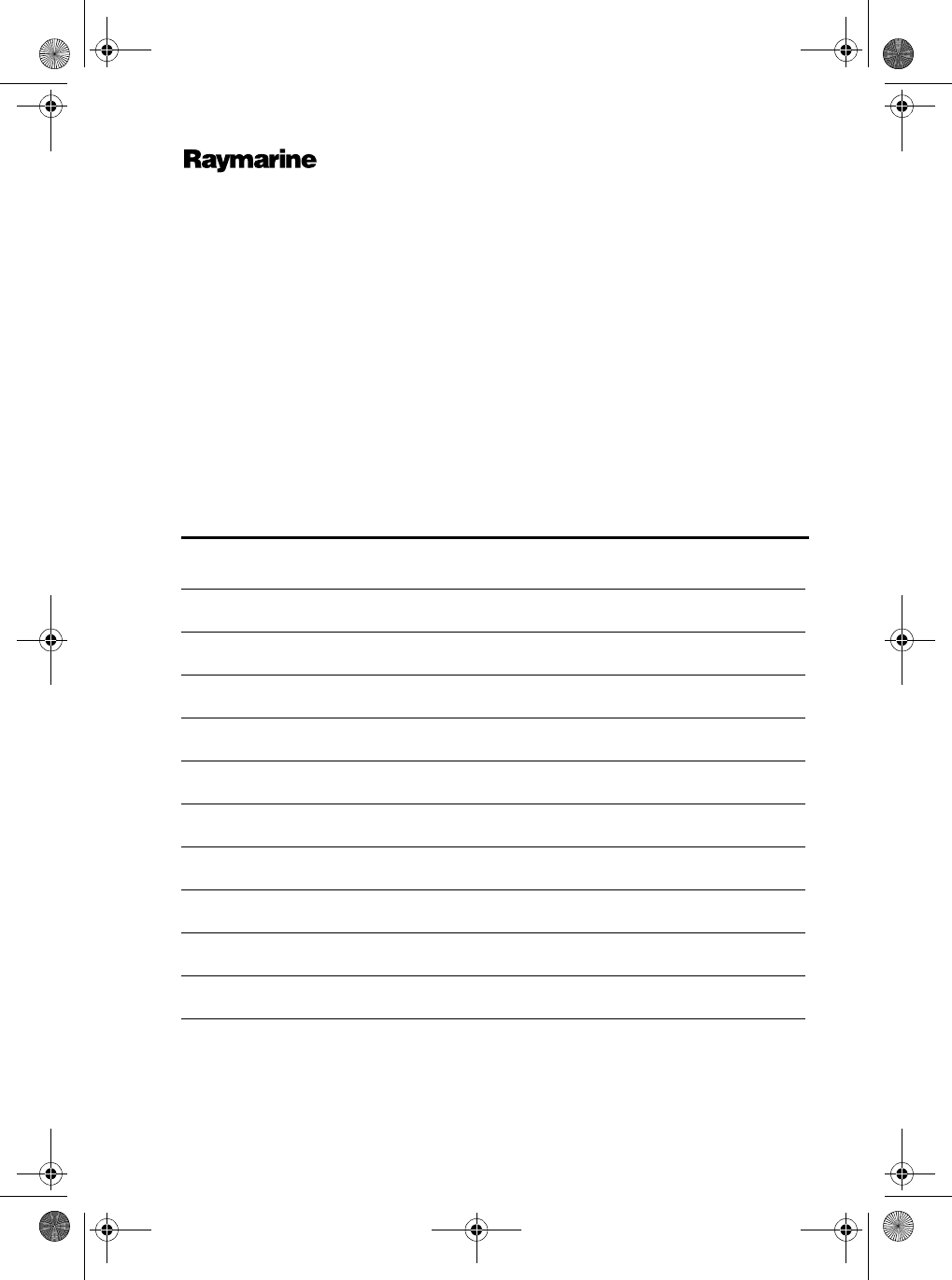
Factory Service Centers
United States of America UK, Europe, Middle East, Far East
Raymarine Inc
22 Cotton Road, Unit D
Nashua, NH 03063-4219, USA
Raymarine Ltd
Anchorage Park, Portsmouth
PO3 5TD, England
Telephone: +1 603 881 5200
Fax: +1 603 864 4756
www.raymarine.com
Telephone: +44 (0)23 9269 3611
Fax: +44 (0)23 9269 4642
www.raymarine.com
Sales & Order Services
Telephone: +1 800 539 5539 Ext. 2333 or
+1 603 881 5200 Ext. 2333
Customer Support
Telephone: +44 (0)23 9271 4713
Fax: +44 (0)23 9266 1228
Technical Support
Telephone: +1 800 539 5539 Ext. 2444 or
+1 603 881 5200 Ext. 2444
www.raymarine.com
www.raymarine.com
Product Repair Center
Telephone: +1 800 539 5539 Ext. 2118
Model number Serial number
Purchased from Purchase date
Dealer address
Installed by Installation date
Commissioned by
Commissioning date
Owner’s name
Mailing address
Phone number E-mail address
This portion should be completed and retained by the owner.
81229_1.book Page 3 Wednesday, November 12, 2003 2:39 PM

81229_1.book Page 4 Wednesday, November 12, 2003 2:39 PM